Unit 5: Management Accounting Semester and Academic Year 2020 - 2021
VerifiedAdded on 2022/03/28
|22
|5556
|222
Assignment
AI Summary
NATIONAL ECONOMICS UNIVERSITY INTERNATIONAL SCHOOL OF MANAGEMENT AND ECONOMICS HIGHER NATIONALS BTEC HIGHER NATIONAL DIPLOMA IN BUSINESS (RQF) Unit Code, NumberandTitle H/601/0548 RQF level 4 - Unit 5: Management Accounting Semester and Academic Semester 1/ Academic year 2020 - 2021 UnitAssessor(s) Nguyen Phuong Hoa / Le Quang Dung AssignmentNumberandTitle MA A2.1: Use of planning tools and management accounting to respond to financial problems techniques (Assessment
Contribute Materials
Your contribution can guide someone’s learning journey. Share your
documents today.
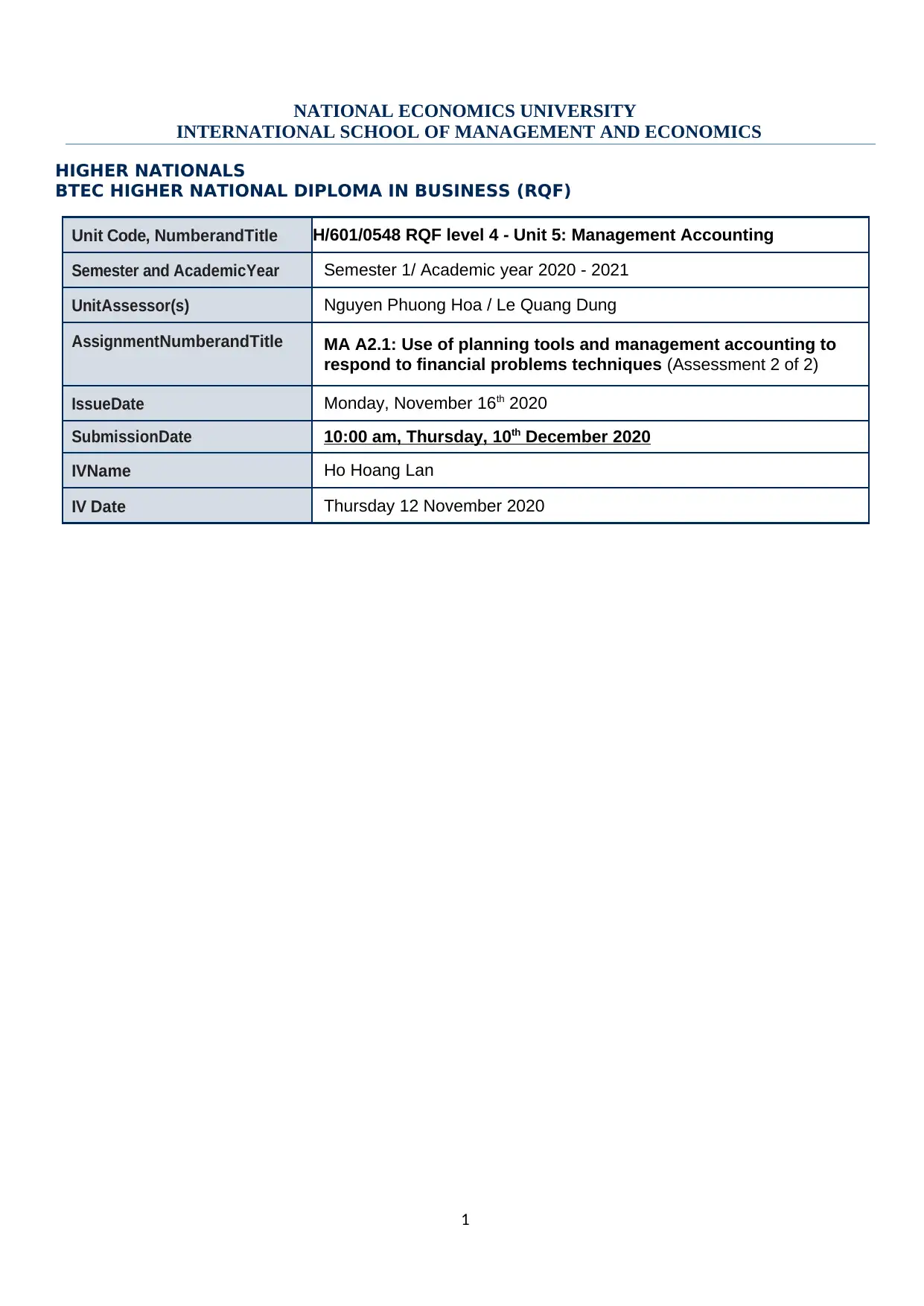
NATIONAL ECONOMICS UNIVERSITY
INTERNATIONAL SCHOOL OF MANAGEMENT AND ECONOMICS
HIGHER NATIONALS
BTEC HIGHER NATIONAL DIPLOMA IN BUSINESS (RQF)
Unit Code, NumberandTitle H/601/0548 RQF level 4 - Unit 5: Management Accounting
Semester and AcademicYear Semester 1/ Academic year 2020 - 2021
UnitAssessor(s) Nguyen Phuong Hoa / Le Quang Dung
Assignment NumberandTitle MA A2.1: Use of planning tools and management accounting to
respond to financial problems techniques (Assessment 2 of 2)
IssueDate Monday, November 16th 2020
SubmissionDate 10:00 am, Thursday, 10th December 2020
IVName Ho Hoang Lan
IV Date Thursday 12 November 2020
1
INTERNATIONAL SCHOOL OF MANAGEMENT AND ECONOMICS
HIGHER NATIONALS
BTEC HIGHER NATIONAL DIPLOMA IN BUSINESS (RQF)
Unit Code, NumberandTitle H/601/0548 RQF level 4 - Unit 5: Management Accounting
Semester and AcademicYear Semester 1/ Academic year 2020 - 2021
UnitAssessor(s) Nguyen Phuong Hoa / Le Quang Dung
Assignment NumberandTitle MA A2.1: Use of planning tools and management accounting to
respond to financial problems techniques (Assessment 2 of 2)
IssueDate Monday, November 16th 2020
SubmissionDate 10:00 am, Thursday, 10th December 2020
IVName Ho Hoang Lan
IV Date Thursday 12 November 2020
1
Secure Best Marks with AI Grader
Need help grading? Try our AI Grader for instant feedback on your assignments.
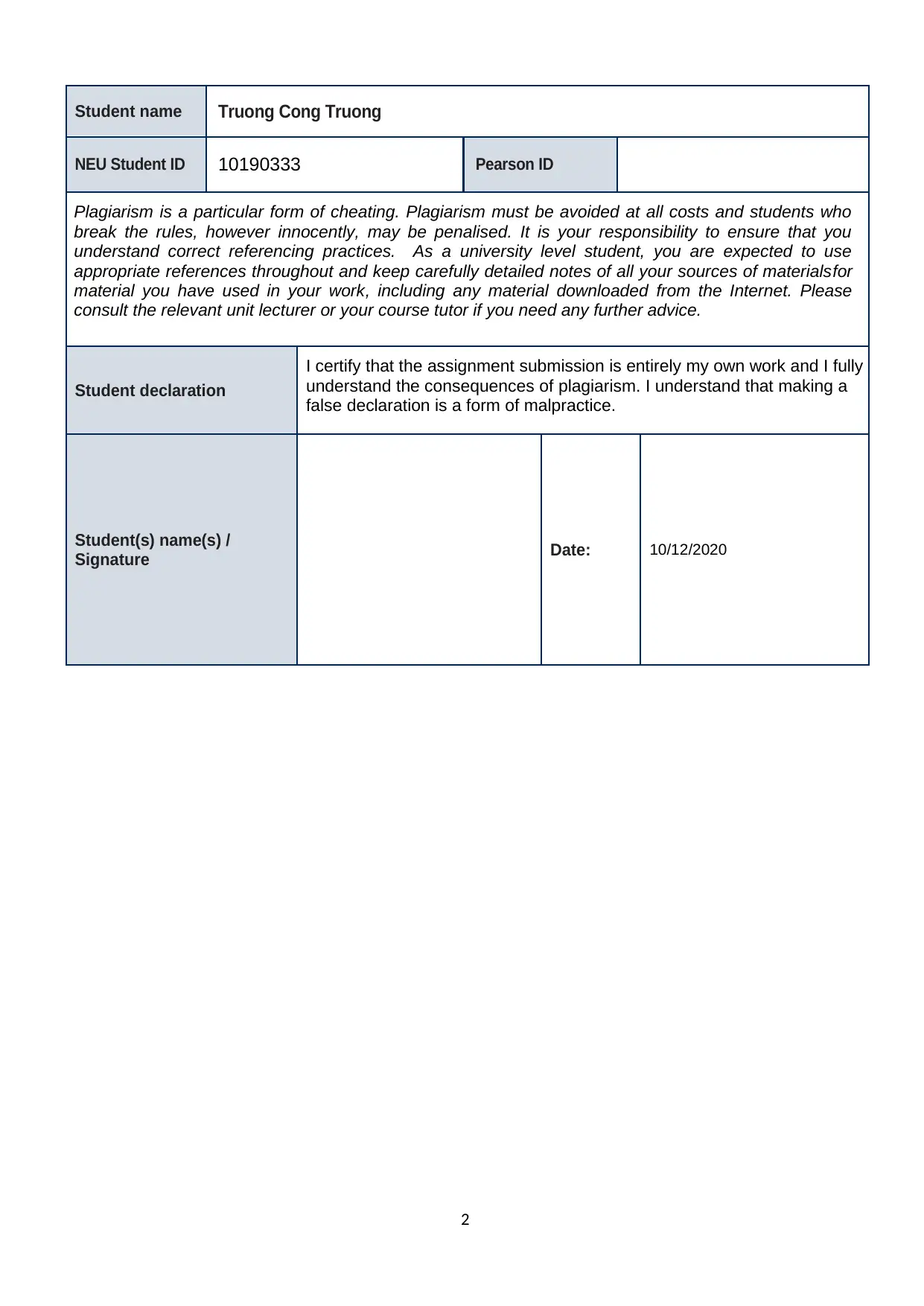
Student name Truong Cong Truong
NEU Student ID 10190333 Pearson ID
Plagiarism is a particular form of cheating. Plagiarism must be avoided at all costs and students who
break the rules, however innocently, may be penalised. It is your responsibility to ensure that you
understand correct referencing practices. As a university level student, you are expected to use
appropriate references throughout and keep carefully detailed notes of all your sources of materialsfor
material you have used in your work, including any material downloaded from the Internet. Please
consult the relevant unit lecturer or your course tutor if you need any further advice.
Student declaration
I certify that the assignment submission is entirely my own work and I fully
understand the consequences of plagiarism. I understand that making a
false declaration is a form of malpractice.
Student(s) name(s) /
Signature Date: 10/12/2020
2
NEU Student ID 10190333 Pearson ID
Plagiarism is a particular form of cheating. Plagiarism must be avoided at all costs and students who
break the rules, however innocently, may be penalised. It is your responsibility to ensure that you
understand correct referencing practices. As a university level student, you are expected to use
appropriate references throughout and keep carefully detailed notes of all your sources of materialsfor
material you have used in your work, including any material downloaded from the Internet. Please
consult the relevant unit lecturer or your course tutor if you need any further advice.
Student declaration
I certify that the assignment submission is entirely my own work and I fully
understand the consequences of plagiarism. I understand that making a
false declaration is a form of malpractice.
Student(s) name(s) /
Signature Date: 10/12/2020
2
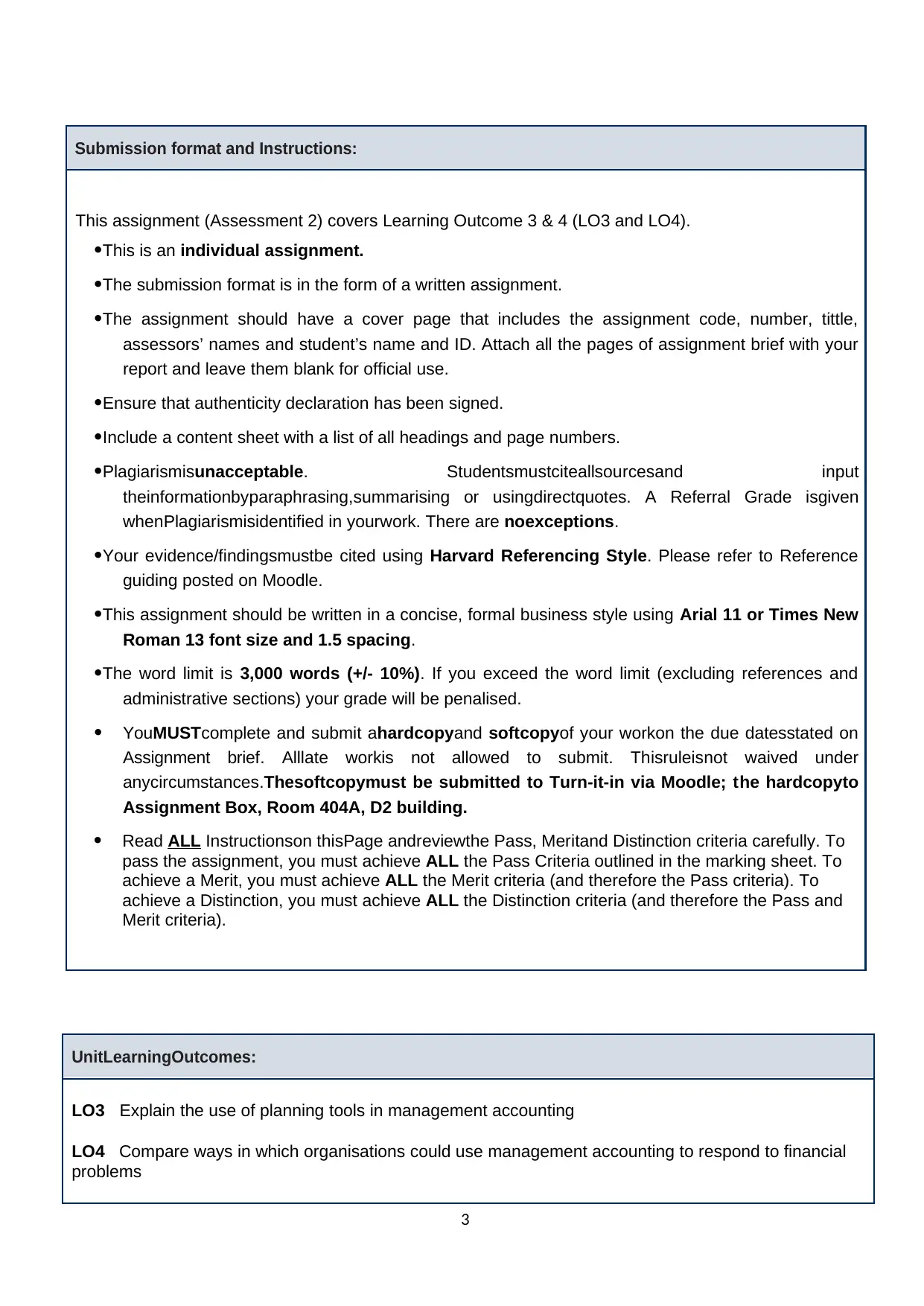
UnitLearningOutcomes:
LO3 Explain the use of planning tools in management accounting
LO4 Compare ways in which organisations could use management accounting to respond to financial
problems
3
Submission format and Instructions:
This assignment (Assessment 2) covers Learning Outcome 3 & 4 (LO3 and LO4).
This is an individual assignment.
The submission format is in the form of a written assignment.
The assignment should have a cover page that includes the assignment code, number, tittle,
assessors’ names and student’s name and ID. Attach all the pages of assignment brief with your
report and leave them blank for official use.
Ensure that authenticity declaration has been signed.
Include a content sheet with a list of all headings and page numbers.
Plagiarismisunacceptable. Studentsmustciteallsourcesand input
theinformationbyparaphrasing,summarising or usingdirectquotes. A Referral Grade isgiven
whenPlagiarismisidentified in yourwork. There are noexceptions.
Your evidence/findingsmustbe cited using Harvard Referencing Style. Please refer to Reference
guiding posted on Moodle.
This assignment should be written in a concise, formal business style using Arial 11 or Times New
Roman 13 font size and 1.5 spacing.
The word limit is 3,000 words (+/- 10%). If you exceed the word limit (excluding references and
administrative sections) your grade will be penalised.
YouMUSTcomplete and submit ahardcopyand softcopyof your workon the due datesstated on
Assignment brief. Alllate workis not allowed to submit. Thisruleisnot waived under
anycircumstances.Thesoftcopymust be submitted to Turn-it-in via Moodle; the hardcopyto
Assignment Box, Room 404A, D2 building.
Read ALL Instructionson thisPage andreviewthe Pass, Meritand Distinction criteria carefully. To
pass the assignment, you must achieve ALL the Pass Criteria outlined in the marking sheet. To
achieve a Merit, you must achieve ALL the Merit criteria (and therefore the Pass criteria). To
achieve a Distinction, you must achieve ALL the Distinction criteria (and therefore the Pass and
Merit criteria).
LO3 Explain the use of planning tools in management accounting
LO4 Compare ways in which organisations could use management accounting to respond to financial
problems
3
Submission format and Instructions:
This assignment (Assessment 2) covers Learning Outcome 3 & 4 (LO3 and LO4).
This is an individual assignment.
The submission format is in the form of a written assignment.
The assignment should have a cover page that includes the assignment code, number, tittle,
assessors’ names and student’s name and ID. Attach all the pages of assignment brief with your
report and leave them blank for official use.
Ensure that authenticity declaration has been signed.
Include a content sheet with a list of all headings and page numbers.
Plagiarismisunacceptable. Studentsmustciteallsourcesand input
theinformationbyparaphrasing,summarising or usingdirectquotes. A Referral Grade isgiven
whenPlagiarismisidentified in yourwork. There are noexceptions.
Your evidence/findingsmustbe cited using Harvard Referencing Style. Please refer to Reference
guiding posted on Moodle.
This assignment should be written in a concise, formal business style using Arial 11 or Times New
Roman 13 font size and 1.5 spacing.
The word limit is 3,000 words (+/- 10%). If you exceed the word limit (excluding references and
administrative sections) your grade will be penalised.
YouMUSTcomplete and submit ahardcopyand softcopyof your workon the due datesstated on
Assignment brief. Alllate workis not allowed to submit. Thisruleisnot waived under
anycircumstances.Thesoftcopymust be submitted to Turn-it-in via Moodle; the hardcopyto
Assignment Box, Room 404A, D2 building.
Read ALL Instructionson thisPage andreviewthe Pass, Meritand Distinction criteria carefully. To
pass the assignment, you must achieve ALL the Pass Criteria outlined in the marking sheet. To
achieve a Merit, you must achieve ALL the Merit criteria (and therefore the Pass criteria). To
achieve a Distinction, you must achieve ALL the Distinction criteria (and therefore the Pass and
Merit criteria).
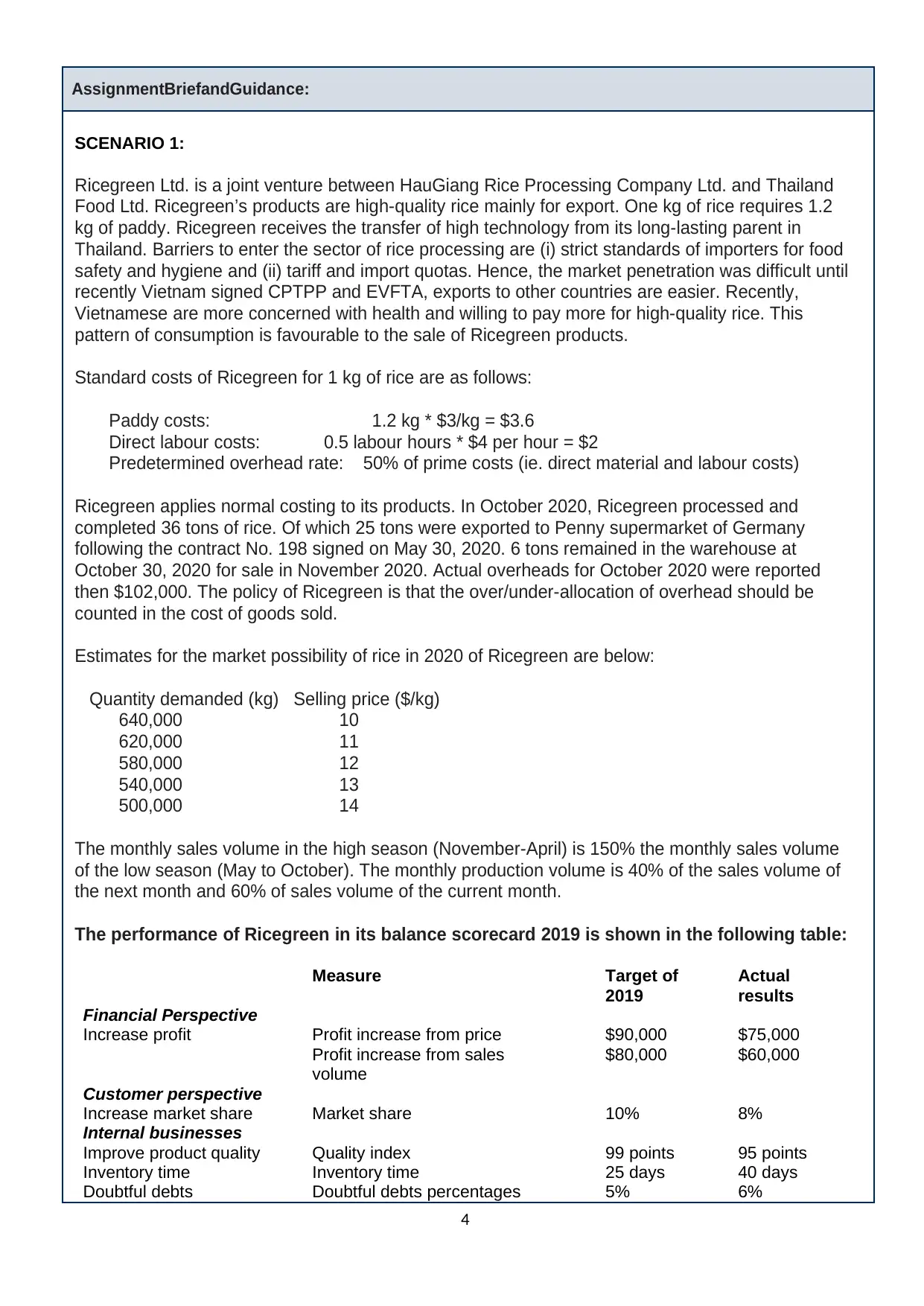
AssignmentBriefandGuidance:
SCENARIO 1:
Ricegreen Ltd. is a joint venture between HauGiang Rice Processing Company Ltd. and Thailand
Food Ltd. Ricegreen’s products are high-quality rice mainly for export. One kg of rice requires 1.2
kg of paddy. Ricegreen receives the transfer of high technology from its long-lasting parent in
Thailand. Barriers to enter the sector of rice processing are (i) strict standards of importers for food
safety and hygiene and (ii) tariff and import quotas. Hence, the market penetration was difficult until
recently Vietnam signed CPTPP and EVFTA, exports to other countries are easier. Recently,
Vietnamese are more concerned with health and willing to pay more for high-quality rice. This
pattern of consumption is favourable to the sale of Ricegreen products.
Standard costs of Ricegreen for 1 kg of rice are as follows:
Paddy costs: 1.2 kg * $3/kg = $3.6
Direct labour costs: 0.5 labour hours * $4 per hour = $2
Predetermined overhead rate: 50% of prime costs (ie. direct material and labour costs)
Ricegreen applies normal costing to its products. In October 2020, Ricegreen processed and
completed 36 tons of rice. Of which 25 tons were exported to Penny supermarket of Germany
following the contract No. 198 signed on May 30, 2020. 6 tons remained in the warehouse at
October 30, 2020 for sale in November 2020. Actual overheads for October 2020 were reported
then $102,000. The policy of Ricegreen is that the over/under-allocation of overhead should be
counted in the cost of goods sold.
Estimates for the market possibility of rice in 2020 of Ricegreen are below:
Quantity demanded (kg) Selling price ($/kg)
640,000 10
620,000 11
580,000 12
540,000 13
500,000 14
The monthly sales volume in the high season (November-April) is 150% the monthly sales volume
of the low season (May to October). The monthly production volume is 40% of the sales volume of
the next month and 60% of sales volume of the current month.
The performance of Ricegreen in its balance scorecard 2019 is shown in the following table:
Measure Target of
2019
Actual
results
Financial Perspective
Increase profit Profit increase from price $90,000 $75,000
Profit increase from sales
volume
$80,000 $60,000
Customer perspective
Increase market share Market share 10% 8%
Internal businesses
Improve product quality Quality index 99 points 95 points
Inventory time Inventory time 25 days 40 days
Doubtful debts Doubtful debts percentages 5% 6%
4
SCENARIO 1:
Ricegreen Ltd. is a joint venture between HauGiang Rice Processing Company Ltd. and Thailand
Food Ltd. Ricegreen’s products are high-quality rice mainly for export. One kg of rice requires 1.2
kg of paddy. Ricegreen receives the transfer of high technology from its long-lasting parent in
Thailand. Barriers to enter the sector of rice processing are (i) strict standards of importers for food
safety and hygiene and (ii) tariff and import quotas. Hence, the market penetration was difficult until
recently Vietnam signed CPTPP and EVFTA, exports to other countries are easier. Recently,
Vietnamese are more concerned with health and willing to pay more for high-quality rice. This
pattern of consumption is favourable to the sale of Ricegreen products.
Standard costs of Ricegreen for 1 kg of rice are as follows:
Paddy costs: 1.2 kg * $3/kg = $3.6
Direct labour costs: 0.5 labour hours * $4 per hour = $2
Predetermined overhead rate: 50% of prime costs (ie. direct material and labour costs)
Ricegreen applies normal costing to its products. In October 2020, Ricegreen processed and
completed 36 tons of rice. Of which 25 tons were exported to Penny supermarket of Germany
following the contract No. 198 signed on May 30, 2020. 6 tons remained in the warehouse at
October 30, 2020 for sale in November 2020. Actual overheads for October 2020 were reported
then $102,000. The policy of Ricegreen is that the over/under-allocation of overhead should be
counted in the cost of goods sold.
Estimates for the market possibility of rice in 2020 of Ricegreen are below:
Quantity demanded (kg) Selling price ($/kg)
640,000 10
620,000 11
580,000 12
540,000 13
500,000 14
The monthly sales volume in the high season (November-April) is 150% the monthly sales volume
of the low season (May to October). The monthly production volume is 40% of the sales volume of
the next month and 60% of sales volume of the current month.
The performance of Ricegreen in its balance scorecard 2019 is shown in the following table:
Measure Target of
2019
Actual
results
Financial Perspective
Increase profit Profit increase from price $90,000 $75,000
Profit increase from sales
volume
$80,000 $60,000
Customer perspective
Increase market share Market share 10% 8%
Internal businesses
Improve product quality Quality index 99 points 95 points
Inventory time Inventory time 25 days 40 days
Doubtful debts Doubtful debts percentages 5% 6%
4
Secure Best Marks with AI Grader
Need help grading? Try our AI Grader for instant feedback on your assignments.
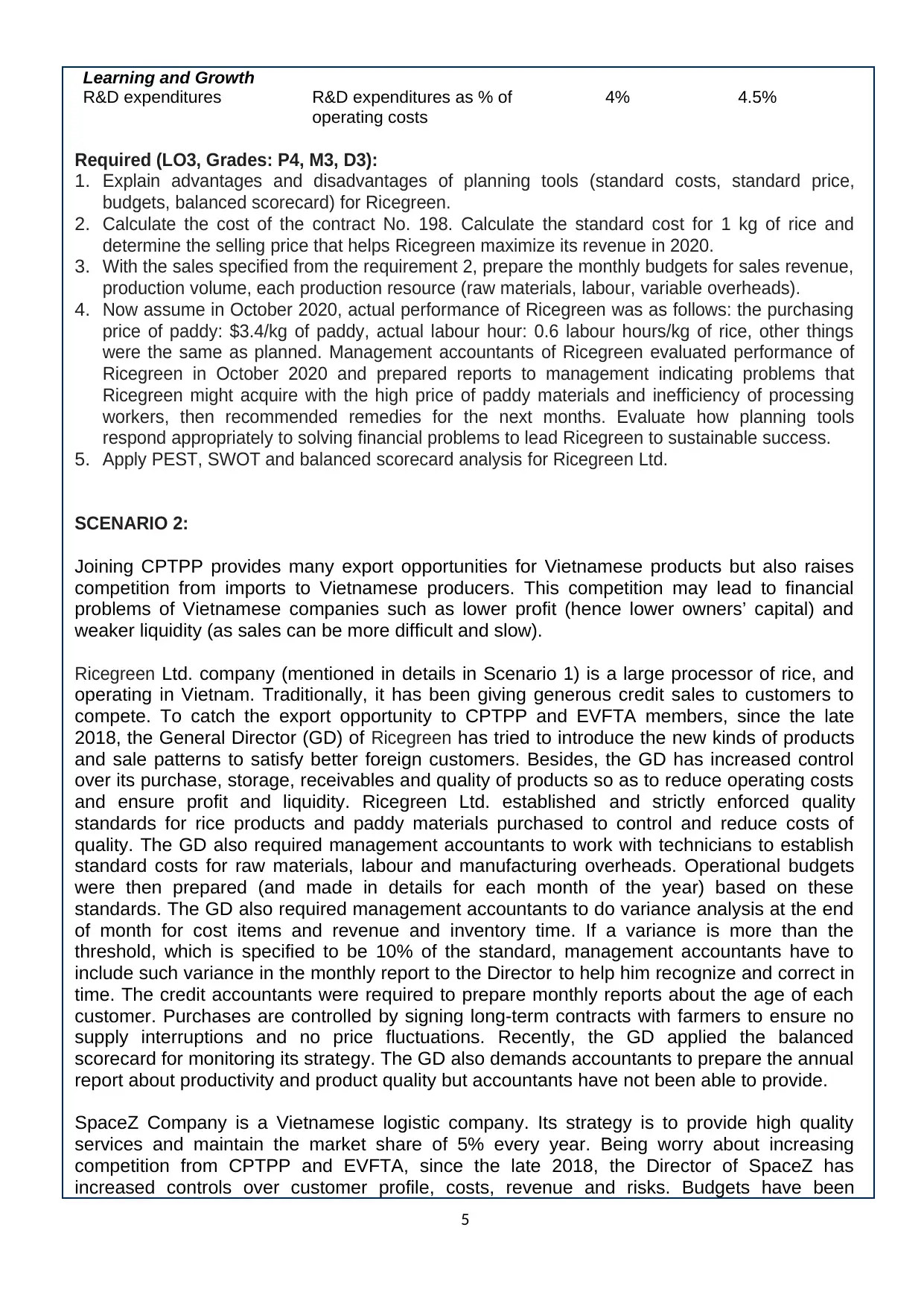
Learning and Growth
R&D expenditures R&D expenditures as % of
operating costs
4% 4.5%
Required (LO3, Grades: P4, M3, D3):
1. Explain advantages and disadvantages of planning tools (standard costs, standard price,
budgets, balanced scorecard) for Ricegreen.
2. Calculate the cost of the contract No. 198. Calculate the standard cost for 1 kg of rice and
determine the selling price that helps Ricegreen maximize its revenue in 2020.
3. With the sales specified from the requirement 2, prepare the monthly budgets for sales revenue,
production volume, each production resource (raw materials, labour, variable overheads).
4. Now assume in October 2020, actual performance of Ricegreen was as follows: the purchasing
price of paddy: $3.4/kg of paddy, actual labour hour: 0.6 labour hours/kg of rice, other things
were the same as planned. Management accountants of Ricegreen evaluated performance of
Ricegreen in October 2020 and prepared reports to management indicating problems that
Ricegreen might acquire with the high price of paddy materials and inefficiency of processing
workers, then recommended remedies for the next months. Evaluate how planning tools
respond appropriately to solving financial problems to lead Ricegreen to sustainable success.
5. Apply PEST, SWOT and balanced scorecard analysis for Ricegreen Ltd.
SCENARIO 2:
Joining CPTPP provides many export opportunities for Vietnamese products but also raises
competition from imports to Vietnamese producers. This competition may lead to financial
problems of Vietnamese companies such as lower profit (hence lower owners’ capital) and
weaker liquidity (as sales can be more difficult and slow).
Ricegreen Ltd. company (mentioned in details in Scenario 1) is a large processor of rice, and
operating in Vietnam. Traditionally, it has been giving generous credit sales to customers to
compete. To catch the export opportunity to CPTPP and EVFTA members, since the late
2018, the General Director (GD) of Ricegreen has tried to introduce the new kinds of products
and sale patterns to satisfy better foreign customers. Besides, the GD has increased control
over its purchase, storage, receivables and quality of products so as to reduce operating costs
and ensure profit and liquidity. Ricegreen Ltd. established and strictly enforced quality
standards for rice products and paddy materials purchased to control and reduce costs of
quality. The GD also required management accountants to work with technicians to establish
standard costs for raw materials, labour and manufacturing overheads. Operational budgets
were then prepared (and made in details for each month of the year) based on these
standards. The GD also required management accountants to do variance analysis at the end
of month for cost items and revenue and inventory time. If a variance is more than the
threshold, which is specified to be 10% of the standard, management accountants have to
include such variance in the monthly report to the Director to help him recognize and correct in
time. The credit accountants were required to prepare monthly reports about the age of each
customer. Purchases are controlled by signing long-term contracts with farmers to ensure no
supply interruptions and no price fluctuations. Recently, the GD applied the balanced
scorecard for monitoring its strategy. The GD also demands accountants to prepare the annual
report about productivity and product quality but accountants have not been able to provide.
SpaceZ Company is a Vietnamese logistic company. Its strategy is to provide high quality
services and maintain the market share of 5% every year. Being worry about increasing
competition from CPTPP and EVFTA, since the late 2018, the Director of SpaceZ has
increased controls over customer profile, costs, revenue and risks. Budgets have been
5
R&D expenditures R&D expenditures as % of
operating costs
4% 4.5%
Required (LO3, Grades: P4, M3, D3):
1. Explain advantages and disadvantages of planning tools (standard costs, standard price,
budgets, balanced scorecard) for Ricegreen.
2. Calculate the cost of the contract No. 198. Calculate the standard cost for 1 kg of rice and
determine the selling price that helps Ricegreen maximize its revenue in 2020.
3. With the sales specified from the requirement 2, prepare the monthly budgets for sales revenue,
production volume, each production resource (raw materials, labour, variable overheads).
4. Now assume in October 2020, actual performance of Ricegreen was as follows: the purchasing
price of paddy: $3.4/kg of paddy, actual labour hour: 0.6 labour hours/kg of rice, other things
were the same as planned. Management accountants of Ricegreen evaluated performance of
Ricegreen in October 2020 and prepared reports to management indicating problems that
Ricegreen might acquire with the high price of paddy materials and inefficiency of processing
workers, then recommended remedies for the next months. Evaluate how planning tools
respond appropriately to solving financial problems to lead Ricegreen to sustainable success.
5. Apply PEST, SWOT and balanced scorecard analysis for Ricegreen Ltd.
SCENARIO 2:
Joining CPTPP provides many export opportunities for Vietnamese products but also raises
competition from imports to Vietnamese producers. This competition may lead to financial
problems of Vietnamese companies such as lower profit (hence lower owners’ capital) and
weaker liquidity (as sales can be more difficult and slow).
Ricegreen Ltd. company (mentioned in details in Scenario 1) is a large processor of rice, and
operating in Vietnam. Traditionally, it has been giving generous credit sales to customers to
compete. To catch the export opportunity to CPTPP and EVFTA members, since the late
2018, the General Director (GD) of Ricegreen has tried to introduce the new kinds of products
and sale patterns to satisfy better foreign customers. Besides, the GD has increased control
over its purchase, storage, receivables and quality of products so as to reduce operating costs
and ensure profit and liquidity. Ricegreen Ltd. established and strictly enforced quality
standards for rice products and paddy materials purchased to control and reduce costs of
quality. The GD also required management accountants to work with technicians to establish
standard costs for raw materials, labour and manufacturing overheads. Operational budgets
were then prepared (and made in details for each month of the year) based on these
standards. The GD also required management accountants to do variance analysis at the end
of month for cost items and revenue and inventory time. If a variance is more than the
threshold, which is specified to be 10% of the standard, management accountants have to
include such variance in the monthly report to the Director to help him recognize and correct in
time. The credit accountants were required to prepare monthly reports about the age of each
customer. Purchases are controlled by signing long-term contracts with farmers to ensure no
supply interruptions and no price fluctuations. Recently, the GD applied the balanced
scorecard for monitoring its strategy. The GD also demands accountants to prepare the annual
report about productivity and product quality but accountants have not been able to provide.
SpaceZ Company is a Vietnamese logistic company. Its strategy is to provide high quality
services and maintain the market share of 5% every year. Being worry about increasing
competition from CPTPP and EVFTA, since the late 2018, the Director of SpaceZ has
increased controls over customer profile, costs, revenue and risks. Budgets have been
5
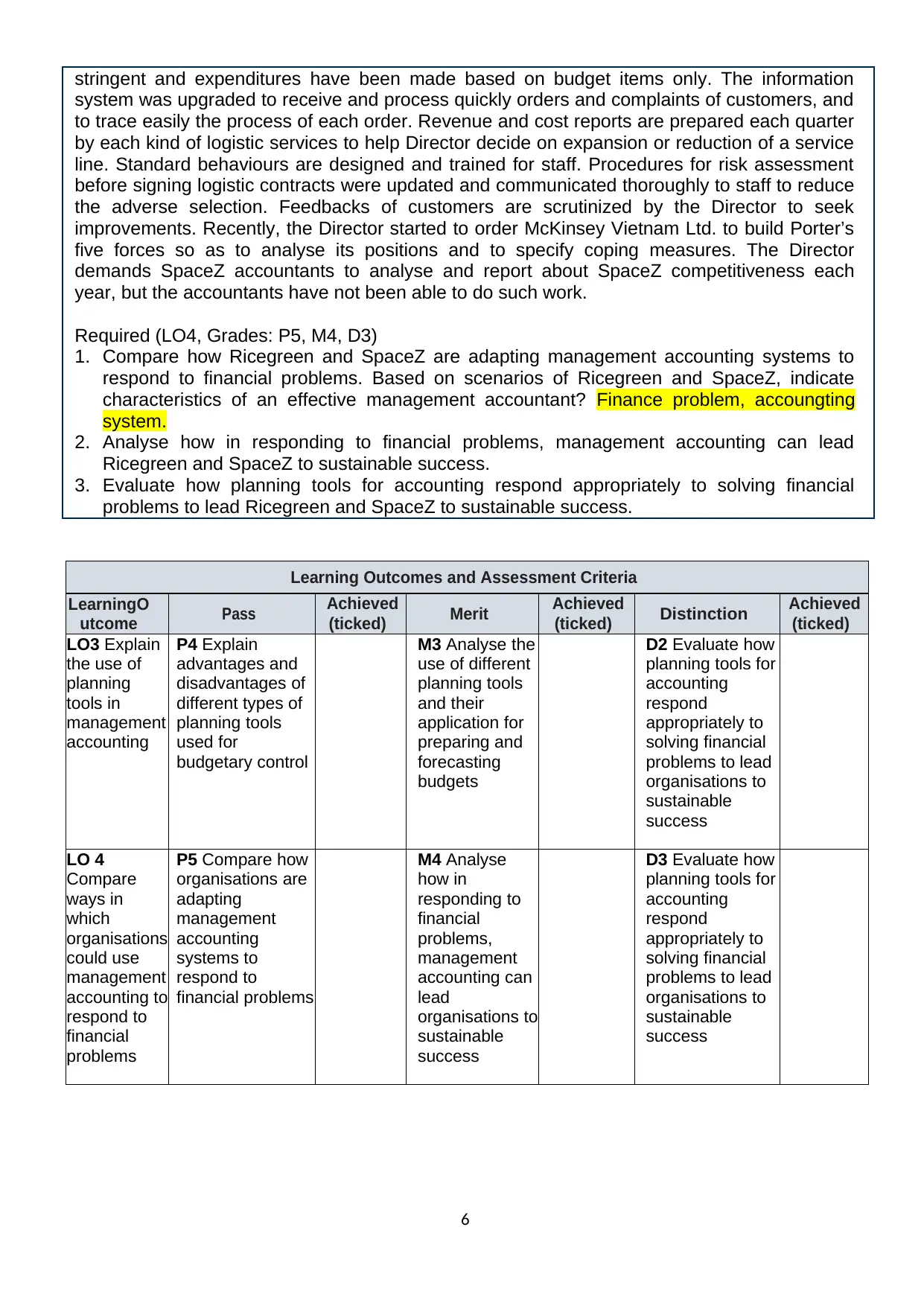
stringent and expenditures have been made based on budget items only. The information
system was upgraded to receive and process quickly orders and complaints of customers, and
to trace easily the process of each order. Revenue and cost reports are prepared each quarter
by each kind of logistic services to help Director decide on expansion or reduction of a service
line. Standard behaviours are designed and trained for staff. Procedures for risk assessment
before signing logistic contracts were updated and communicated thoroughly to staff to reduce
the adverse selection. Feedbacks of customers are scrutinized by the Director to seek
improvements. Recently, the Director started to order McKinsey Vietnam Ltd. to build Porter’s
five forces so as to analyse its positions and to specify coping measures. The Director
demands SpaceZ accountants to analyse and report about SpaceZ competitiveness each
year, but the accountants have not been able to do such work.
Required (LO4, Grades: P5, M4, D3)
1. Compare how Ricegreen and SpaceZ are adapting management accounting systems to
respond to financial problems. Based on scenarios of Ricegreen and SpaceZ, indicate
characteristics of an effective management accountant? Finance problem, accoungting
system.
2. Analyse how in responding to financial problems, management accounting can lead
Ricegreen and SpaceZ to sustainable success.
3. Evaluate how planning tools for accounting respond appropriately to solving financial
problems to lead Ricegreen and SpaceZ to sustainable success.
Learning Outcomes and Assessment Criteria
LearningO
utcome Pass Achieved
(ticked) Merit Achieved
(ticked) Distinction Achieved
(ticked)
LO3 Explain
the use of
planning
tools in
management
accounting
P4 Explain
advantages and
disadvantages of
different types of
planning tools
used for
budgetary control
M3 Analyse the
use of different
planning tools
and their
application for
preparing and
forecasting
budgets
D2 Evaluate how
planning tools for
accounting
respond
appropriately to
solving financial
problems to lead
organisations to
sustainable
success
LO 4
Compare
ways in
which
organisations
could use
management
accounting to
respond to
financial
problems
P5 Compare how
organisations are
adapting
management
accounting
systems to
respond to
financial problems
M4 Analyse
how in
responding to
financial
problems,
management
accounting can
lead
organisations to
sustainable
success
D3 Evaluate how
planning tools for
accounting
respond
appropriately to
solving financial
problems to lead
organisations to
sustainable
success
6
system was upgraded to receive and process quickly orders and complaints of customers, and
to trace easily the process of each order. Revenue and cost reports are prepared each quarter
by each kind of logistic services to help Director decide on expansion or reduction of a service
line. Standard behaviours are designed and trained for staff. Procedures for risk assessment
before signing logistic contracts were updated and communicated thoroughly to staff to reduce
the adverse selection. Feedbacks of customers are scrutinized by the Director to seek
improvements. Recently, the Director started to order McKinsey Vietnam Ltd. to build Porter’s
five forces so as to analyse its positions and to specify coping measures. The Director
demands SpaceZ accountants to analyse and report about SpaceZ competitiveness each
year, but the accountants have not been able to do such work.
Required (LO4, Grades: P5, M4, D3)
1. Compare how Ricegreen and SpaceZ are adapting management accounting systems to
respond to financial problems. Based on scenarios of Ricegreen and SpaceZ, indicate
characteristics of an effective management accountant? Finance problem, accoungting
system.
2. Analyse how in responding to financial problems, management accounting can lead
Ricegreen and SpaceZ to sustainable success.
3. Evaluate how planning tools for accounting respond appropriately to solving financial
problems to lead Ricegreen and SpaceZ to sustainable success.
Learning Outcomes and Assessment Criteria
LearningO
utcome Pass Achieved
(ticked) Merit Achieved
(ticked) Distinction Achieved
(ticked)
LO3 Explain
the use of
planning
tools in
management
accounting
P4 Explain
advantages and
disadvantages of
different types of
planning tools
used for
budgetary control
M3 Analyse the
use of different
planning tools
and their
application for
preparing and
forecasting
budgets
D2 Evaluate how
planning tools for
accounting
respond
appropriately to
solving financial
problems to lead
organisations to
sustainable
success
LO 4
Compare
ways in
which
organisations
could use
management
accounting to
respond to
financial
problems
P5 Compare how
organisations are
adapting
management
accounting
systems to
respond to
financial problems
M4 Analyse
how in
responding to
financial
problems,
management
accounting can
lead
organisations to
sustainable
success
D3 Evaluate how
planning tools for
accounting
respond
appropriately to
solving financial
problems to lead
organisations to
sustainable
success
6
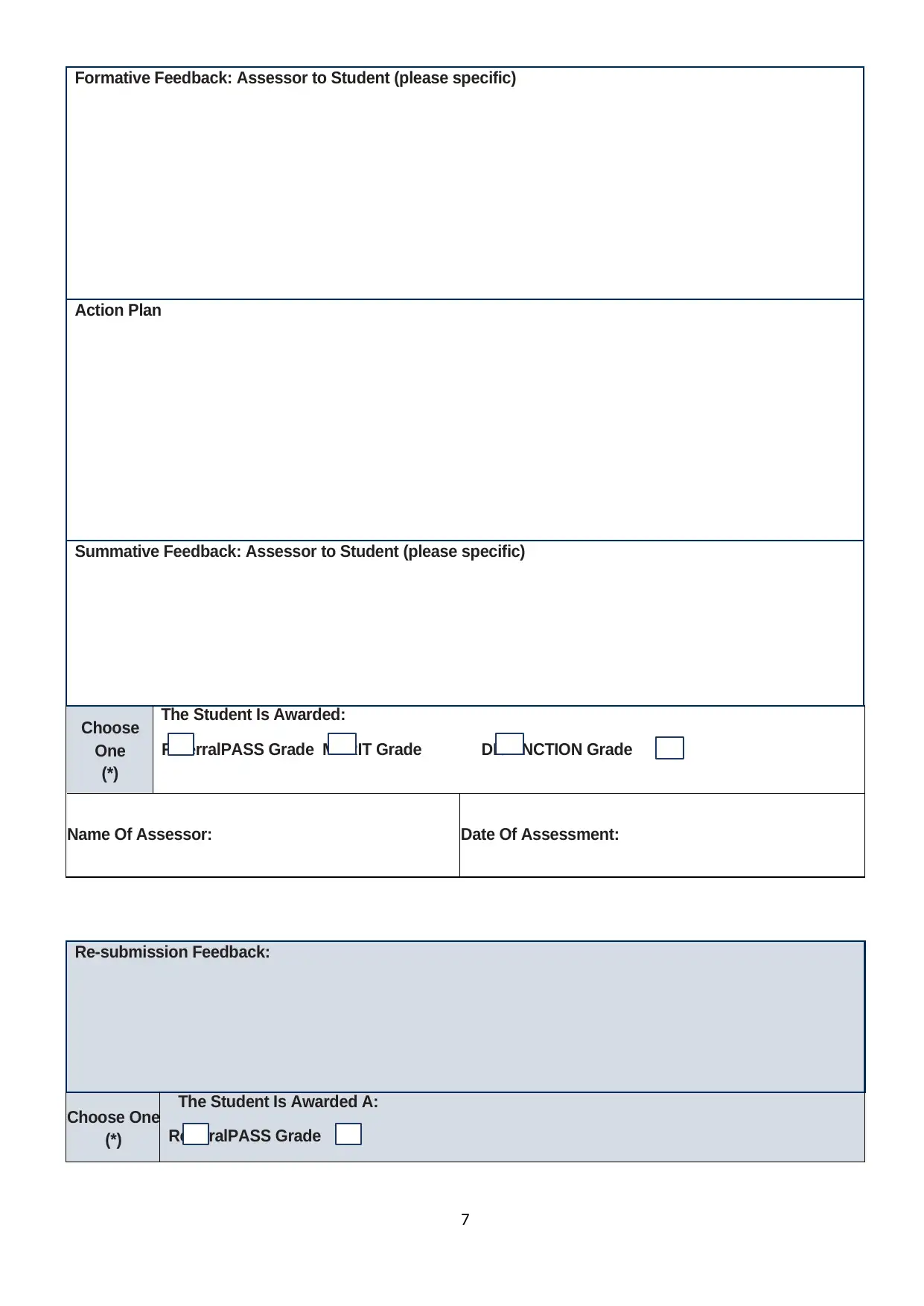
Formative Feedback: Assessor to Student (please specific)
Action Plan
Summative Feedback: Assessor to Student (please specific)
Choose
One
(*)
The Student Is Awarded:
ReferralPASS Grade MERIT Grade DISTINCTION Grade
Name Of Assessor: Date Of Assessment:
Re-submission Feedback:
Choose One
(*)
The Student Is Awarded A:
ReferralPASS Grade
7
Action Plan
Summative Feedback: Assessor to Student (please specific)
Choose
One
(*)
The Student Is Awarded:
ReferralPASS Grade MERIT Grade DISTINCTION Grade
Name Of Assessor: Date Of Assessment:
Re-submission Feedback:
Choose One
(*)
The Student Is Awarded A:
ReferralPASS Grade
7
Paraphrase This Document
Need a fresh take? Get an instant paraphrase of this document with our AI Paraphraser
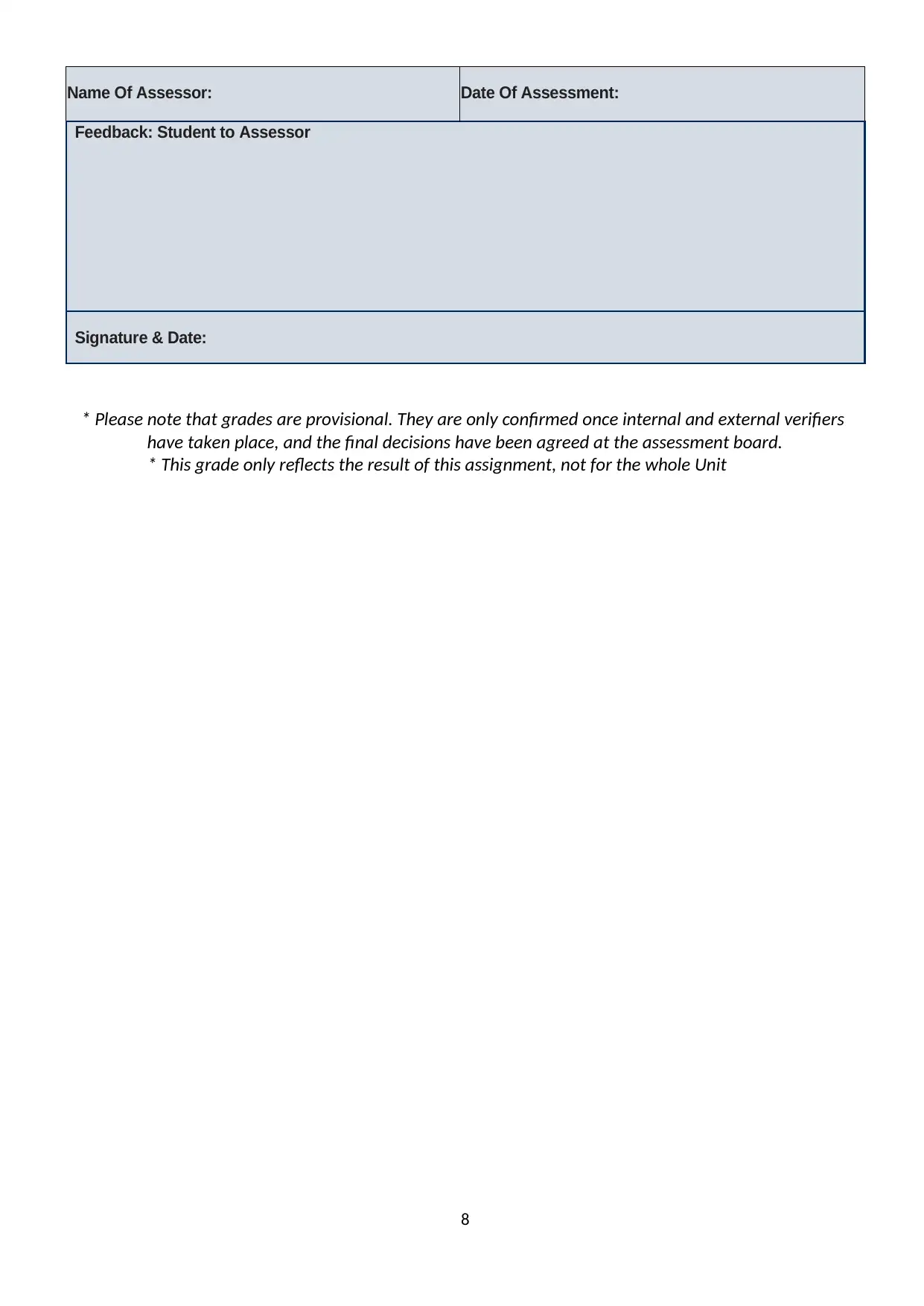
Name Of Assessor: Date Of Assessment:
Feedback: Student to Assessor
Signature & Date:
* Please note that grades are provisional. They are only confirmed once internal and external verifiers
have taken place, and the final decisions have been agreed at the assessment board.
* This grade only reflects the result of this assignment, not for the whole Unit
8
Feedback: Student to Assessor
Signature & Date:
* Please note that grades are provisional. They are only confirmed once internal and external verifiers
have taken place, and the final decisions have been agreed at the assessment board.
* This grade only reflects the result of this assignment, not for the whole Unit
8
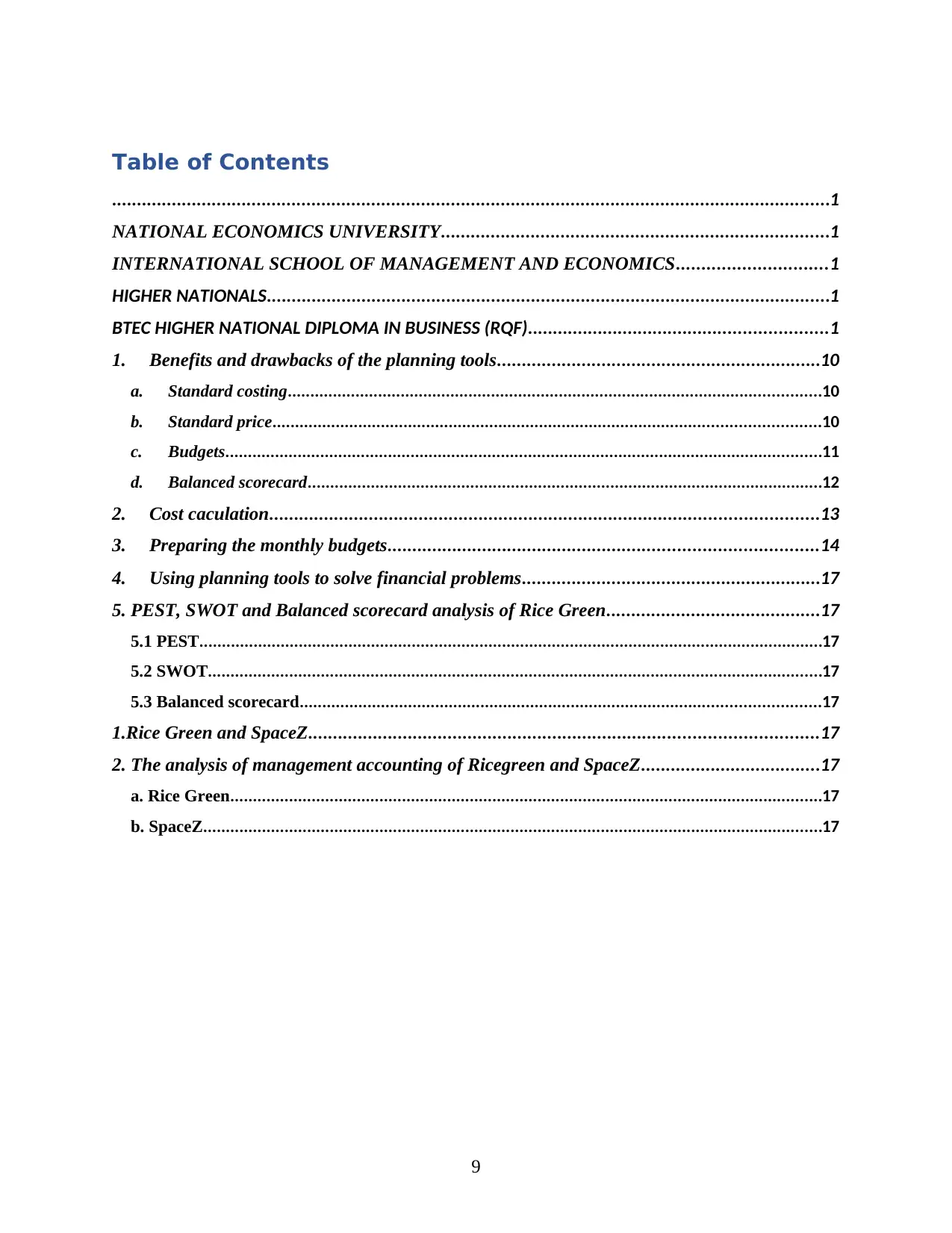
Table of Contents
................................................................................................................................................1
NATIONAL ECONOMICS UNIVERSITY..............................................................................1
INTERNATIONAL SCHOOL OF MANAGEMENT AND ECONOMICS..............................1
HIGHER NATIONALS.................................................................................................................1
BTEC HIGHER NATIONAL DIPLOMA IN BUSINESS (RQF)............................................................1
1. Benefits and drawbacks of the planning tools.................................................................10
a. Standard costing......................................................................................................................10
b. Standard price.........................................................................................................................10
c. Budgets....................................................................................................................................11
d. Balanced scorecard..................................................................................................................12
2. Cost caculation..............................................................................................................13
3. Preparing the monthly budgets......................................................................................14
4. Using planning tools to solve financial problems............................................................17
5. PEST, SWOT and Balanced scorecard analysis of Rice Green...........................................17
5.1 PEST..........................................................................................................................................17
5.2 SWOT........................................................................................................................................17
5.3 Balanced scorecard...................................................................................................................17
1.Rice Green and SpaceZ......................................................................................................17
2. The analysis of management accounting of Ricegreen and SpaceZ....................................17
a. Rice Green...................................................................................................................................17
b. SpaceZ.........................................................................................................................................17
9
................................................................................................................................................1
NATIONAL ECONOMICS UNIVERSITY..............................................................................1
INTERNATIONAL SCHOOL OF MANAGEMENT AND ECONOMICS..............................1
HIGHER NATIONALS.................................................................................................................1
BTEC HIGHER NATIONAL DIPLOMA IN BUSINESS (RQF)............................................................1
1. Benefits and drawbacks of the planning tools.................................................................10
a. Standard costing......................................................................................................................10
b. Standard price.........................................................................................................................10
c. Budgets....................................................................................................................................11
d. Balanced scorecard..................................................................................................................12
2. Cost caculation..............................................................................................................13
3. Preparing the monthly budgets......................................................................................14
4. Using planning tools to solve financial problems............................................................17
5. PEST, SWOT and Balanced scorecard analysis of Rice Green...........................................17
5.1 PEST..........................................................................................................................................17
5.2 SWOT........................................................................................................................................17
5.3 Balanced scorecard...................................................................................................................17
1.Rice Green and SpaceZ......................................................................................................17
2. The analysis of management accounting of Ricegreen and SpaceZ....................................17
a. Rice Green...................................................................................................................................17
b. SpaceZ.........................................................................................................................................17
9
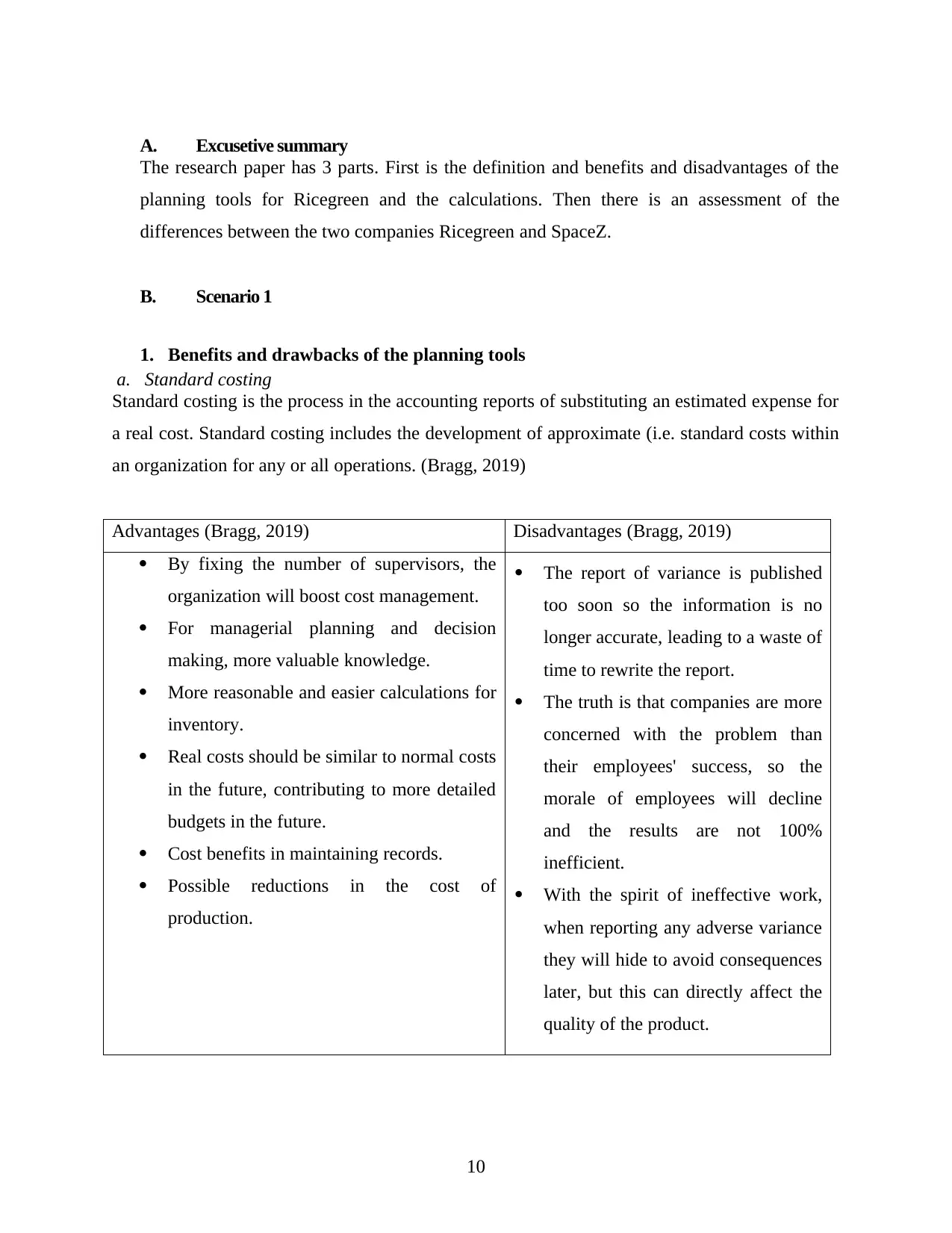
A. Excusetive summary
The research paper has 3 parts. First is the definition and benefits and disadvantages of the
planning tools for Ricegreen and the calculations. Then there is an assessment of the
differences between the two companies Ricegreen and SpaceZ.
B. Scenario 1
1. Benefits and drawbacks of the planning tools
a. Standard costing
Standard costing is the process in the accounting reports of substituting an estimated expense for
a real cost. Standard costing includes the development of approximate (i.e. standard costs within
an organization for any or all operations. (Bragg, 2019)
Advantages (Bragg, 2019) Disadvantages (Bragg, 2019)
By fixing the number of supervisors, the
organization will boost cost management.
For managerial planning and decision
making, more valuable knowledge.
More reasonable and easier calculations for
inventory.
Real costs should be similar to normal costs
in the future, contributing to more detailed
budgets in the future.
Cost benefits in maintaining records.
Possible reductions in the cost of
production.
The report of variance is published
too soon so the information is no
longer accurate, leading to a waste of
time to rewrite the report.
The truth is that companies are more
concerned with the problem than
their employees' success, so the
morale of employees will decline
and the results are not 100%
inefficient.
With the spirit of ineffective work,
when reporting any adverse variance
they will hide to avoid consequences
later, but this can directly affect the
quality of the product.
10
The research paper has 3 parts. First is the definition and benefits and disadvantages of the
planning tools for Ricegreen and the calculations. Then there is an assessment of the
differences between the two companies Ricegreen and SpaceZ.
B. Scenario 1
1. Benefits and drawbacks of the planning tools
a. Standard costing
Standard costing is the process in the accounting reports of substituting an estimated expense for
a real cost. Standard costing includes the development of approximate (i.e. standard costs within
an organization for any or all operations. (Bragg, 2019)
Advantages (Bragg, 2019) Disadvantages (Bragg, 2019)
By fixing the number of supervisors, the
organization will boost cost management.
For managerial planning and decision
making, more valuable knowledge.
More reasonable and easier calculations for
inventory.
Real costs should be similar to normal costs
in the future, contributing to more detailed
budgets in the future.
Cost benefits in maintaining records.
Possible reductions in the cost of
production.
The report of variance is published
too soon so the information is no
longer accurate, leading to a waste of
time to rewrite the report.
The truth is that companies are more
concerned with the problem than
their employees' success, so the
morale of employees will decline
and the results are not 100%
inefficient.
With the spirit of ineffective work,
when reporting any adverse variance
they will hide to avoid consequences
later, but this can directly affect the
quality of the product.
10
Secure Best Marks with AI Grader
Need help grading? Try our AI Grader for instant feedback on your assignments.
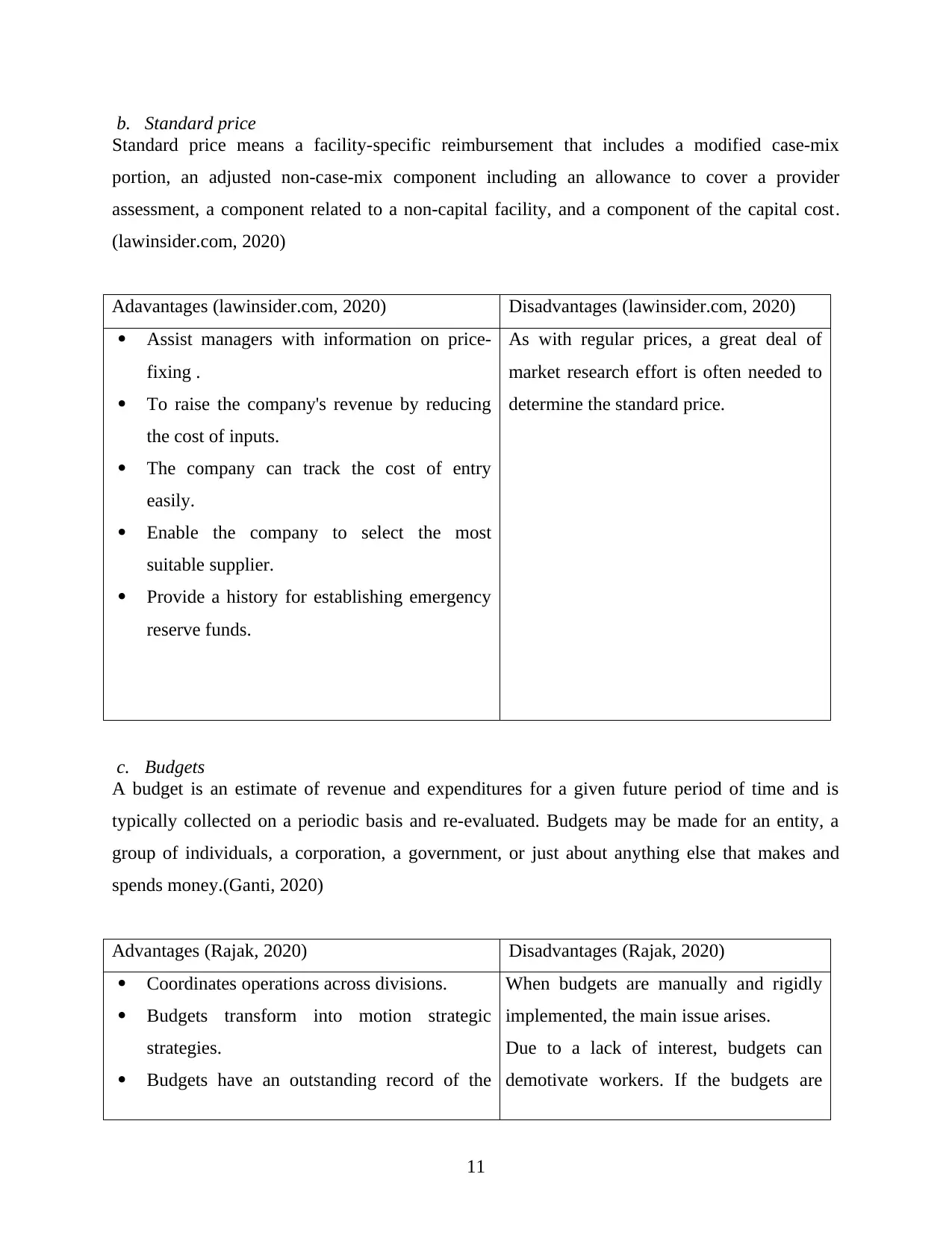
b. Standard price
Standard price means a facility-specific reimbursement that includes a modified case-mix
portion, an adjusted non-case-mix component including an allowance to cover a provider
assessment, a component related to a non-capital facility, and a component of the capital cost.
(lawinsider.com, 2020)
Adavantages (lawinsider.com, 2020) Disadvantages (lawinsider.com, 2020)
Assist managers with information on price-
fixing .
To raise the company's revenue by reducing
the cost of inputs.
The company can track the cost of entry
easily.
Enable the company to select the most
suitable supplier.
Provide a history for establishing emergency
reserve funds.
As with regular prices, a great deal of
market research effort is often needed to
determine the standard price.
c. Budgets
A budget is an estimate of revenue and expenditures for a given future period of time and is
typically collected on a periodic basis and re-evaluated. Budgets may be made for an entity, a
group of individuals, a corporation, a government, or just about anything else that makes and
spends money.(Ganti, 2020)
Advantages (Rajak, 2020) Disadvantages (Rajak, 2020)
Coordinates operations across divisions.
Budgets transform into motion strategic
strategies.
Budgets have an outstanding record of the
When budgets are manually and rigidly
implemented, the main issue arises.
Due to a lack of interest, budgets can
demotivate workers. If the budgets are
11
Standard price means a facility-specific reimbursement that includes a modified case-mix
portion, an adjusted non-case-mix component including an allowance to cover a provider
assessment, a component related to a non-capital facility, and a component of the capital cost.
(lawinsider.com, 2020)
Adavantages (lawinsider.com, 2020) Disadvantages (lawinsider.com, 2020)
Assist managers with information on price-
fixing .
To raise the company's revenue by reducing
the cost of inputs.
The company can track the cost of entry
easily.
Enable the company to select the most
suitable supplier.
Provide a history for establishing emergency
reserve funds.
As with regular prices, a great deal of
market research effort is often needed to
determine the standard price.
c. Budgets
A budget is an estimate of revenue and expenditures for a given future period of time and is
typically collected on a periodic basis and re-evaluated. Budgets may be made for an entity, a
group of individuals, a corporation, a government, or just about anything else that makes and
spends money.(Ganti, 2020)
Advantages (Rajak, 2020) Disadvantages (Rajak, 2020)
Coordinates operations across divisions.
Budgets transform into motion strategic
strategies.
Budgets have an outstanding record of the
When budgets are manually and rigidly
implemented, the main issue arises.
Due to a lack of interest, budgets can
demotivate workers. If the budgets are
11
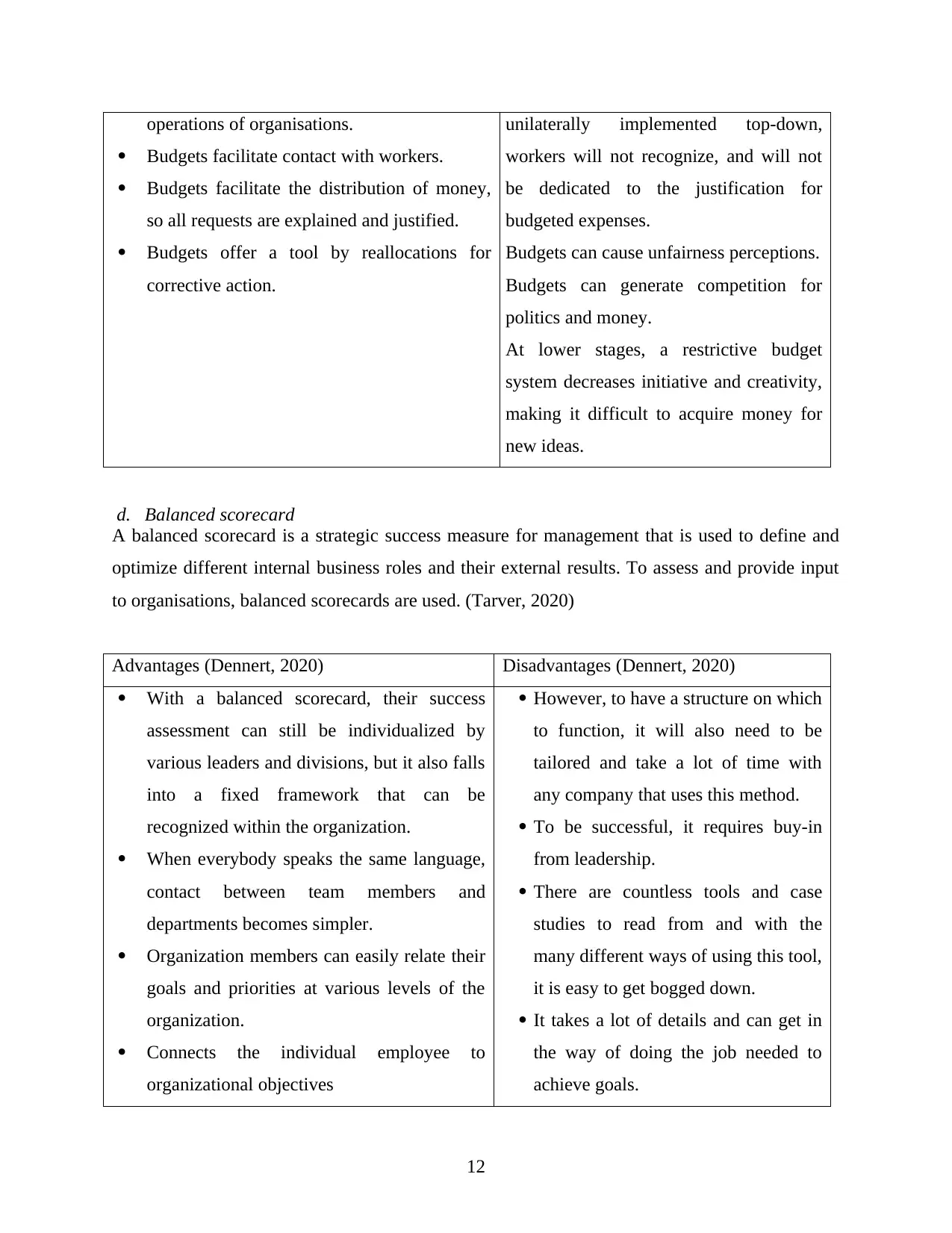
operations of organisations.
Budgets facilitate contact with workers.
Budgets facilitate the distribution of money,
so all requests are explained and justified.
Budgets offer a tool by reallocations for
corrective action.
unilaterally implemented top-down,
workers will not recognize, and will not
be dedicated to the justification for
budgeted expenses.
Budgets can cause unfairness perceptions.
Budgets can generate competition for
politics and money.
At lower stages, a restrictive budget
system decreases initiative and creativity,
making it difficult to acquire money for
new ideas.
d. Balanced scorecard
A balanced scorecard is a strategic success measure for management that is used to define and
optimize different internal business roles and their external results. To assess and provide input
to organisations, balanced scorecards are used. (Tarver, 2020)
Advantages (Dennert, 2020) Disadvantages (Dennert, 2020)
With a balanced scorecard, their success
assessment can still be individualized by
various leaders and divisions, but it also falls
into a fixed framework that can be
recognized within the organization.
When everybody speaks the same language,
contact between team members and
departments becomes simpler.
Organization members can easily relate their
goals and priorities at various levels of the
organization.
Connects the individual employee to
organizational objectives
However, to have a structure on which
to function, it will also need to be
tailored and take a lot of time with
any company that uses this method.
To be successful, it requires buy-in
from leadership.
There are countless tools and case
studies to read from and with the
many different ways of using this tool,
it is easy to get bogged down.
It takes a lot of details and can get in
the way of doing the job needed to
achieve goals.
12
Budgets facilitate contact with workers.
Budgets facilitate the distribution of money,
so all requests are explained and justified.
Budgets offer a tool by reallocations for
corrective action.
unilaterally implemented top-down,
workers will not recognize, and will not
be dedicated to the justification for
budgeted expenses.
Budgets can cause unfairness perceptions.
Budgets can generate competition for
politics and money.
At lower stages, a restrictive budget
system decreases initiative and creativity,
making it difficult to acquire money for
new ideas.
d. Balanced scorecard
A balanced scorecard is a strategic success measure for management that is used to define and
optimize different internal business roles and their external results. To assess and provide input
to organisations, balanced scorecards are used. (Tarver, 2020)
Advantages (Dennert, 2020) Disadvantages (Dennert, 2020)
With a balanced scorecard, their success
assessment can still be individualized by
various leaders and divisions, but it also falls
into a fixed framework that can be
recognized within the organization.
When everybody speaks the same language,
contact between team members and
departments becomes simpler.
Organization members can easily relate their
goals and priorities at various levels of the
organization.
Connects the individual employee to
organizational objectives
However, to have a structure on which
to function, it will also need to be
tailored and take a lot of time with
any company that uses this method.
To be successful, it requires buy-in
from leadership.
There are countless tools and case
studies to read from and with the
many different ways of using this tool,
it is easy to get bogged down.
It takes a lot of details and can get in
the way of doing the job needed to
achieve goals.
12
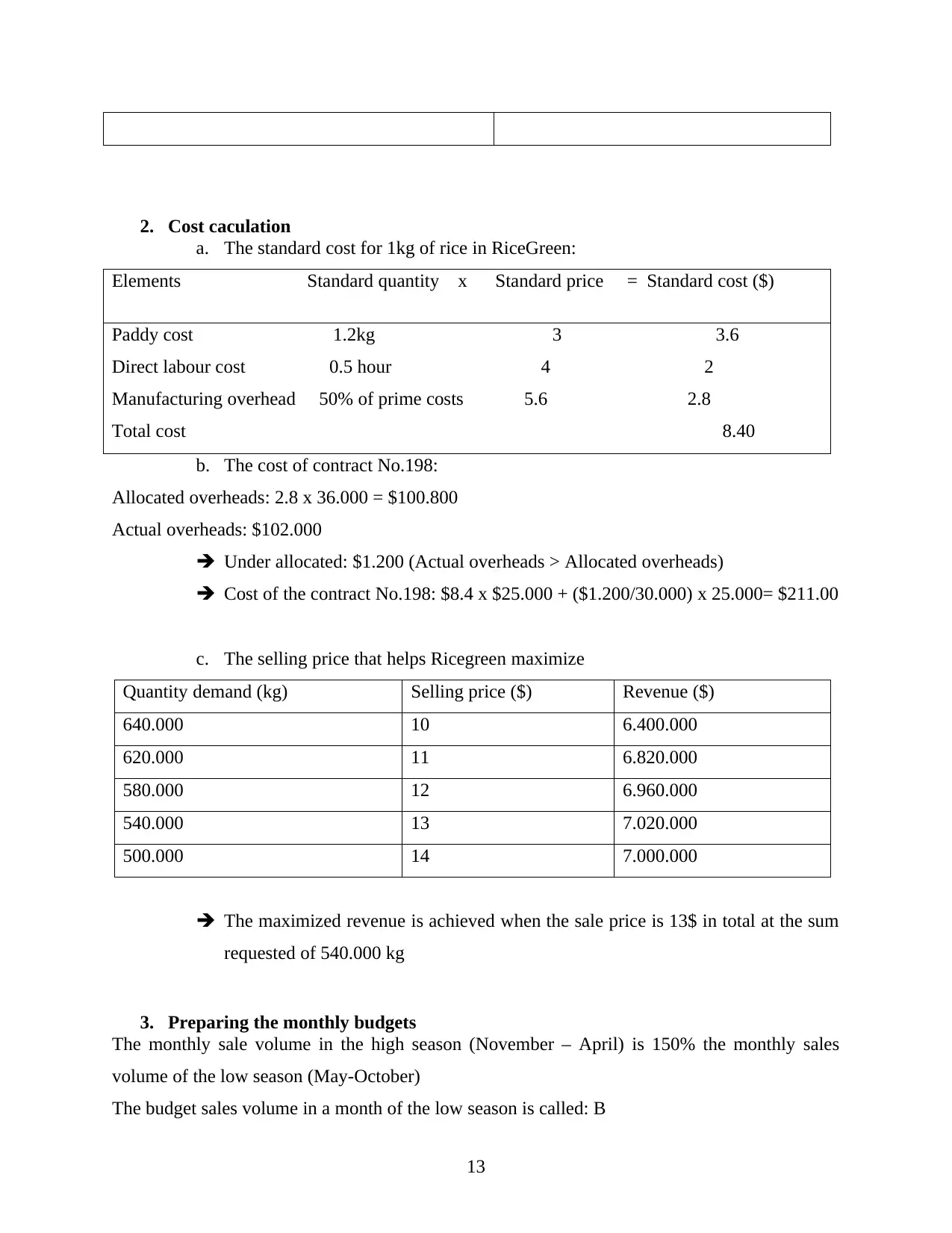
2. Cost caculation
a. The standard cost for 1kg of rice in RiceGreen:
Elements Standard quantity x Standard price = Standard cost ($)
Paddy cost 1.2kg 3 3.6
Direct labour cost 0.5 hour 4 2
Manufacturing overhead 50% of prime costs 5.6 2.8
Total cost 8.40
b. The cost of contract No.198:
Allocated overheads: 2.8 x 36.000 = $100.800
Actual overheads: $102.000
Under allocated: $1.200 (Actual overheads > Allocated overheads)
Cost of the contract No.198: $8.4 x $25.000 + ($1.200/30.000) x 25.000= $211.00
c. The selling price that helps Ricegreen maximize
Quantity demand (kg) Selling price ($) Revenue ($)
640.000 10 6.400.000
620.000 11 6.820.000
580.000 12 6.960.000
540.000 13 7.020.000
500.000 14 7.000.000
The maximized revenue is achieved when the sale price is 13$ in total at the sum
requested of 540.000 kg
3. Preparing the monthly budgets
The monthly sale volume in the high season (November – April) is 150% the monthly sales
volume of the low season (May-October)
The budget sales volume in a month of the low season is called: B
13
a. The standard cost for 1kg of rice in RiceGreen:
Elements Standard quantity x Standard price = Standard cost ($)
Paddy cost 1.2kg 3 3.6
Direct labour cost 0.5 hour 4 2
Manufacturing overhead 50% of prime costs 5.6 2.8
Total cost 8.40
b. The cost of contract No.198:
Allocated overheads: 2.8 x 36.000 = $100.800
Actual overheads: $102.000
Under allocated: $1.200 (Actual overheads > Allocated overheads)
Cost of the contract No.198: $8.4 x $25.000 + ($1.200/30.000) x 25.000= $211.00
c. The selling price that helps Ricegreen maximize
Quantity demand (kg) Selling price ($) Revenue ($)
640.000 10 6.400.000
620.000 11 6.820.000
580.000 12 6.960.000
540.000 13 7.020.000
500.000 14 7.000.000
The maximized revenue is achieved when the sale price is 13$ in total at the sum
requested of 540.000 kg
3. Preparing the monthly budgets
The monthly sale volume in the high season (November – April) is 150% the monthly sales
volume of the low season (May-October)
The budget sales volume in a month of the low season is called: B
13
Paraphrase This Document
Need a fresh take? Get an instant paraphrase of this document with our AI Paraphraser
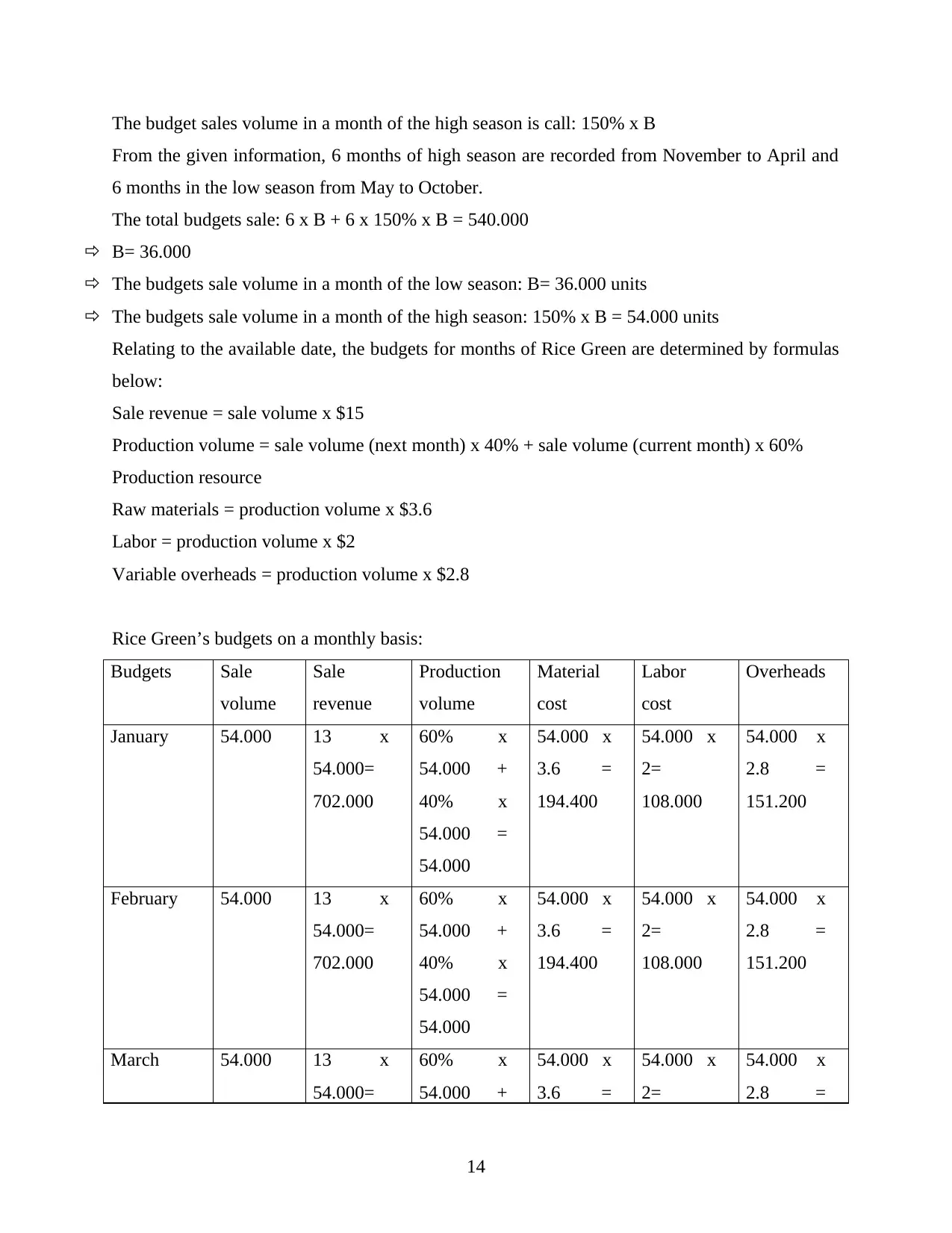
The budget sales volume in a month of the high season is call: 150% x B
From the given information, 6 months of high season are recorded from November to April and
6 months in the low season from May to October.
The total budgets sale: 6 x B + 6 x 150% x B = 540.000
B= 36.000
The budgets sale volume in a month of the low season: B= 36.000 units
The budgets sale volume in a month of the high season: 150% x B = 54.000 units
Relating to the available date, the budgets for months of Rice Green are determined by formulas
below:
Sale revenue = sale volume x $15
Production volume = sale volume (next month) x 40% + sale volume (current month) x 60%
Production resource
Raw materials = production volume x $3.6
Labor = production volume x $2
Variable overheads = production volume x $2.8
Rice Green’s budgets on a monthly basis:
Budgets Sale
volume
Sale
revenue
Production
volume
Material
cost
Labor
cost
Overheads
January 54.000 13 x
54.000=
702.000
60% x
54.000 +
40% x
54.000 =
54.000
54.000 x
3.6 =
194.400
54.000 x
2=
108.000
54.000 x
2.8 =
151.200
February 54.000 13 x
54.000=
702.000
60% x
54.000 +
40% x
54.000 =
54.000
54.000 x
3.6 =
194.400
54.000 x
2=
108.000
54.000 x
2.8 =
151.200
March 54.000 13 x
54.000=
60% x
54.000 +
54.000 x
3.6 =
54.000 x
2=
54.000 x
2.8 =
14
From the given information, 6 months of high season are recorded from November to April and
6 months in the low season from May to October.
The total budgets sale: 6 x B + 6 x 150% x B = 540.000
B= 36.000
The budgets sale volume in a month of the low season: B= 36.000 units
The budgets sale volume in a month of the high season: 150% x B = 54.000 units
Relating to the available date, the budgets for months of Rice Green are determined by formulas
below:
Sale revenue = sale volume x $15
Production volume = sale volume (next month) x 40% + sale volume (current month) x 60%
Production resource
Raw materials = production volume x $3.6
Labor = production volume x $2
Variable overheads = production volume x $2.8
Rice Green’s budgets on a monthly basis:
Budgets Sale
volume
Sale
revenue
Production
volume
Material
cost
Labor
cost
Overheads
January 54.000 13 x
54.000=
702.000
60% x
54.000 +
40% x
54.000 =
54.000
54.000 x
3.6 =
194.400
54.000 x
2=
108.000
54.000 x
2.8 =
151.200
February 54.000 13 x
54.000=
702.000
60% x
54.000 +
40% x
54.000 =
54.000
54.000 x
3.6 =
194.400
54.000 x
2=
108.000
54.000 x
2.8 =
151.200
March 54.000 13 x
54.000=
60% x
54.000 +
54.000 x
3.6 =
54.000 x
2=
54.000 x
2.8 =
14
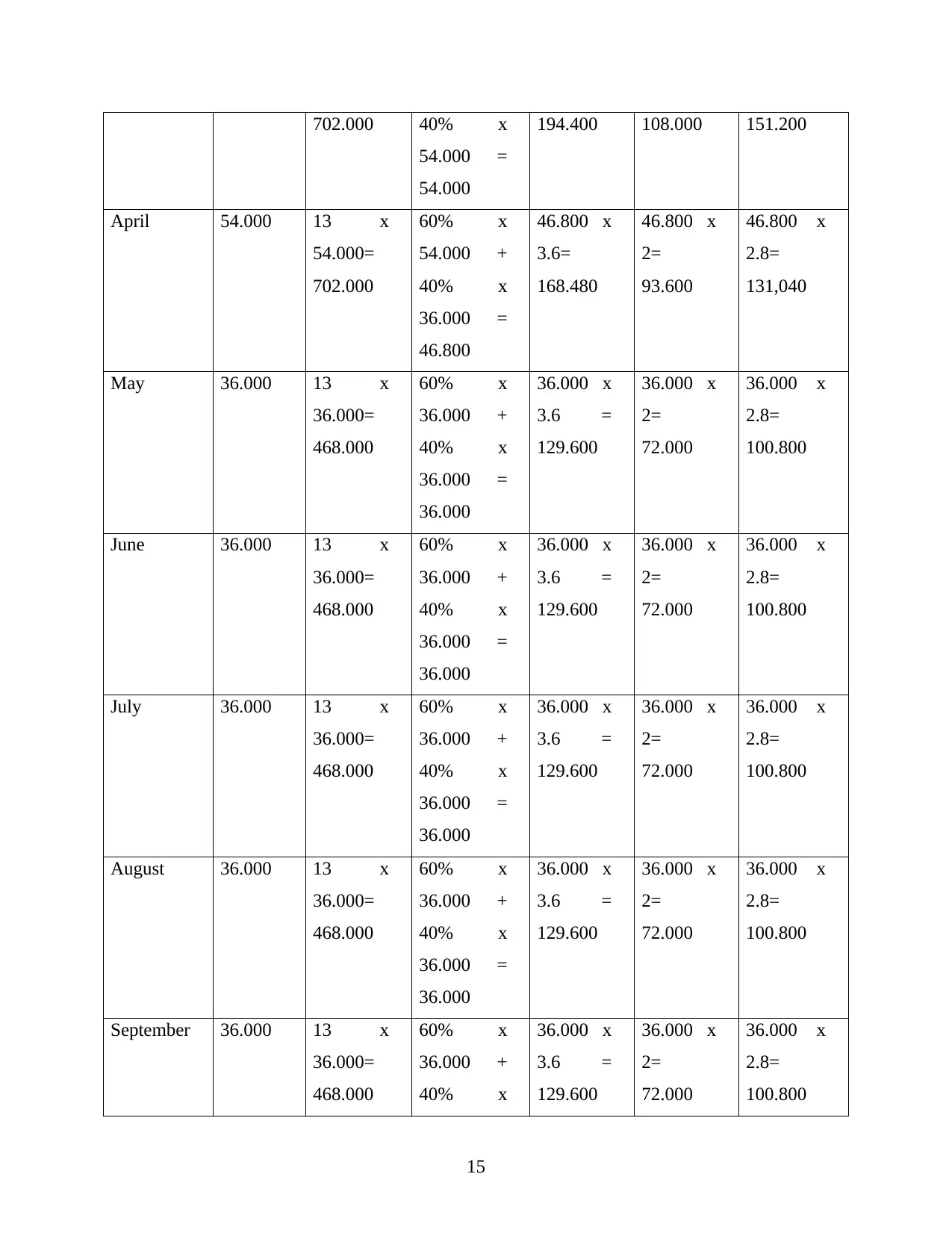
702.000 40% x
54.000 =
54.000
194.400 108.000 151.200
April 54.000 13 x
54.000=
702.000
60% x
54.000 +
40% x
36.000 =
46.800
46.800 x
3.6=
168.480
46.800 x
2=
93.600
46.800 x
2.8=
131,040
May 36.000 13 x
36.000=
468.000
60% x
36.000 +
40% x
36.000 =
36.000
36.000 x
3.6 =
129.600
36.000 x
2=
72.000
36.000 x
2.8=
100.800
June 36.000 13 x
36.000=
468.000
60% x
36.000 +
40% x
36.000 =
36.000
36.000 x
3.6 =
129.600
36.000 x
2=
72.000
36.000 x
2.8=
100.800
July 36.000 13 x
36.000=
468.000
60% x
36.000 +
40% x
36.000 =
36.000
36.000 x
3.6 =
129.600
36.000 x
2=
72.000
36.000 x
2.8=
100.800
August 36.000 13 x
36.000=
468.000
60% x
36.000 +
40% x
36.000 =
36.000
36.000 x
3.6 =
129.600
36.000 x
2=
72.000
36.000 x
2.8=
100.800
September 36.000 13 x
36.000=
468.000
60% x
36.000 +
40% x
36.000 x
3.6 =
129.600
36.000 x
2=
72.000
36.000 x
2.8=
100.800
15
54.000 =
54.000
194.400 108.000 151.200
April 54.000 13 x
54.000=
702.000
60% x
54.000 +
40% x
36.000 =
46.800
46.800 x
3.6=
168.480
46.800 x
2=
93.600
46.800 x
2.8=
131,040
May 36.000 13 x
36.000=
468.000
60% x
36.000 +
40% x
36.000 =
36.000
36.000 x
3.6 =
129.600
36.000 x
2=
72.000
36.000 x
2.8=
100.800
June 36.000 13 x
36.000=
468.000
60% x
36.000 +
40% x
36.000 =
36.000
36.000 x
3.6 =
129.600
36.000 x
2=
72.000
36.000 x
2.8=
100.800
July 36.000 13 x
36.000=
468.000
60% x
36.000 +
40% x
36.000 =
36.000
36.000 x
3.6 =
129.600
36.000 x
2=
72.000
36.000 x
2.8=
100.800
August 36.000 13 x
36.000=
468.000
60% x
36.000 +
40% x
36.000 =
36.000
36.000 x
3.6 =
129.600
36.000 x
2=
72.000
36.000 x
2.8=
100.800
September 36.000 13 x
36.000=
468.000
60% x
36.000 +
40% x
36.000 x
3.6 =
129.600
36.000 x
2=
72.000
36.000 x
2.8=
100.800
15
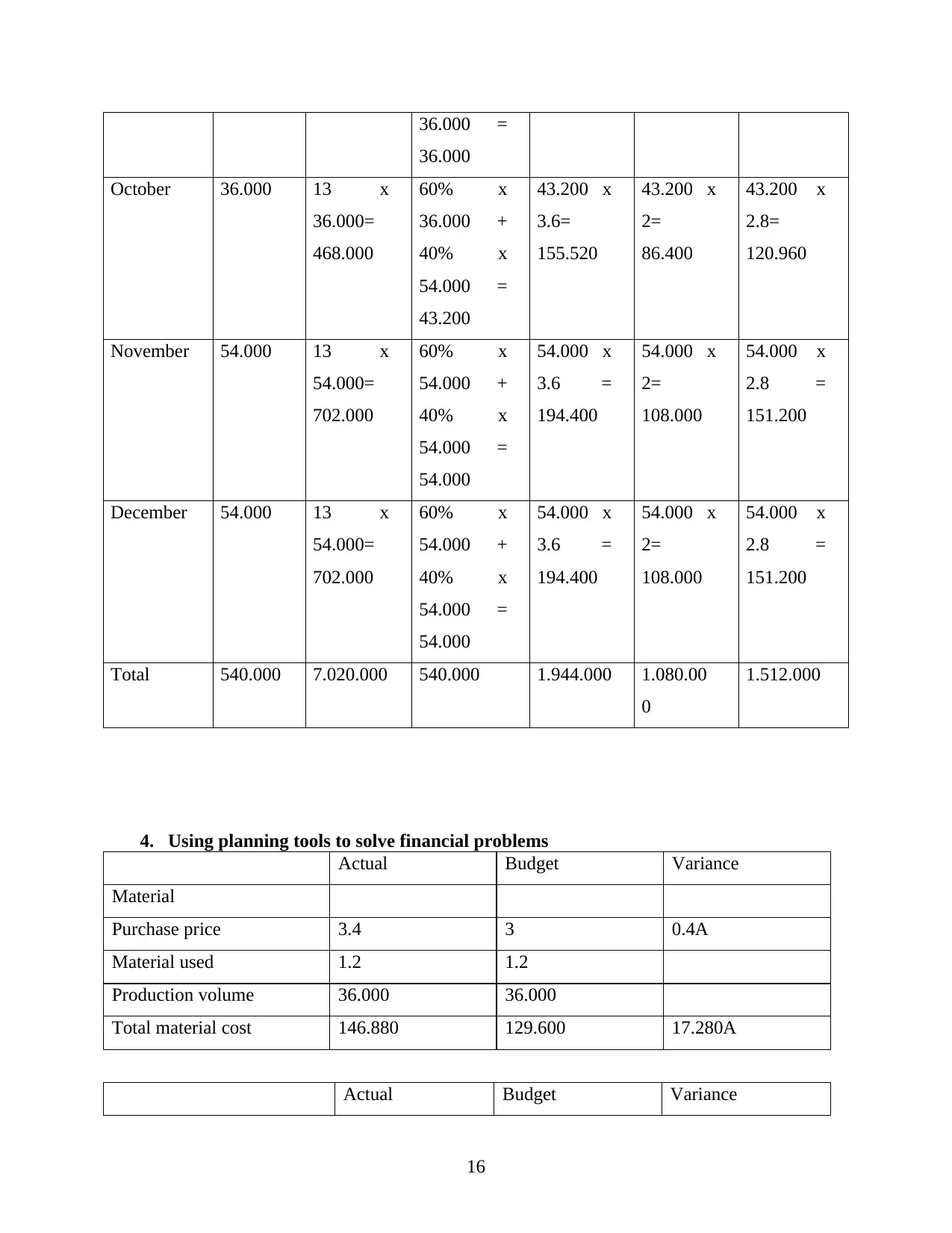
36.000 =
36.000
October 36.000 13 x
36.000=
468.000
60% x
36.000 +
40% x
54.000 =
43.200
43.200 x
3.6=
155.520
43.200 x
2=
86.400
43.200 x
2.8=
120.960
November 54.000 13 x
54.000=
702.000
60% x
54.000 +
40% x
54.000 =
54.000
54.000 x
3.6 =
194.400
54.000 x
2=
108.000
54.000 x
2.8 =
151.200
December 54.000 13 x
54.000=
702.000
60% x
54.000 +
40% x
54.000 =
54.000
54.000 x
3.6 =
194.400
54.000 x
2=
108.000
54.000 x
2.8 =
151.200
Total 540.000 7.020.000 540.000 1.944.000 1.080.00
0
1.512.000
4. Using planning tools to solve financial problems
Actual Budget Variance
Material
Purchase price 3.4 3 0.4A
Material used 1.2 1.2
Production volume 36.000 36.000
Total material cost 146.880 129.600 17.280A
Actual Budget Variance
16
36.000
October 36.000 13 x
36.000=
468.000
60% x
36.000 +
40% x
54.000 =
43.200
43.200 x
3.6=
155.520
43.200 x
2=
86.400
43.200 x
2.8=
120.960
November 54.000 13 x
54.000=
702.000
60% x
54.000 +
40% x
54.000 =
54.000
54.000 x
3.6 =
194.400
54.000 x
2=
108.000
54.000 x
2.8 =
151.200
December 54.000 13 x
54.000=
702.000
60% x
54.000 +
40% x
54.000 =
54.000
54.000 x
3.6 =
194.400
54.000 x
2=
108.000
54.000 x
2.8 =
151.200
Total 540.000 7.020.000 540.000 1.944.000 1.080.00
0
1.512.000
4. Using planning tools to solve financial problems
Actual Budget Variance
Material
Purchase price 3.4 3 0.4A
Material used 1.2 1.2
Production volume 36.000 36.000
Total material cost 146.880 129.600 17.280A
Actual Budget Variance
16
Secure Best Marks with AI Grader
Need help grading? Try our AI Grader for instant feedback on your assignments.
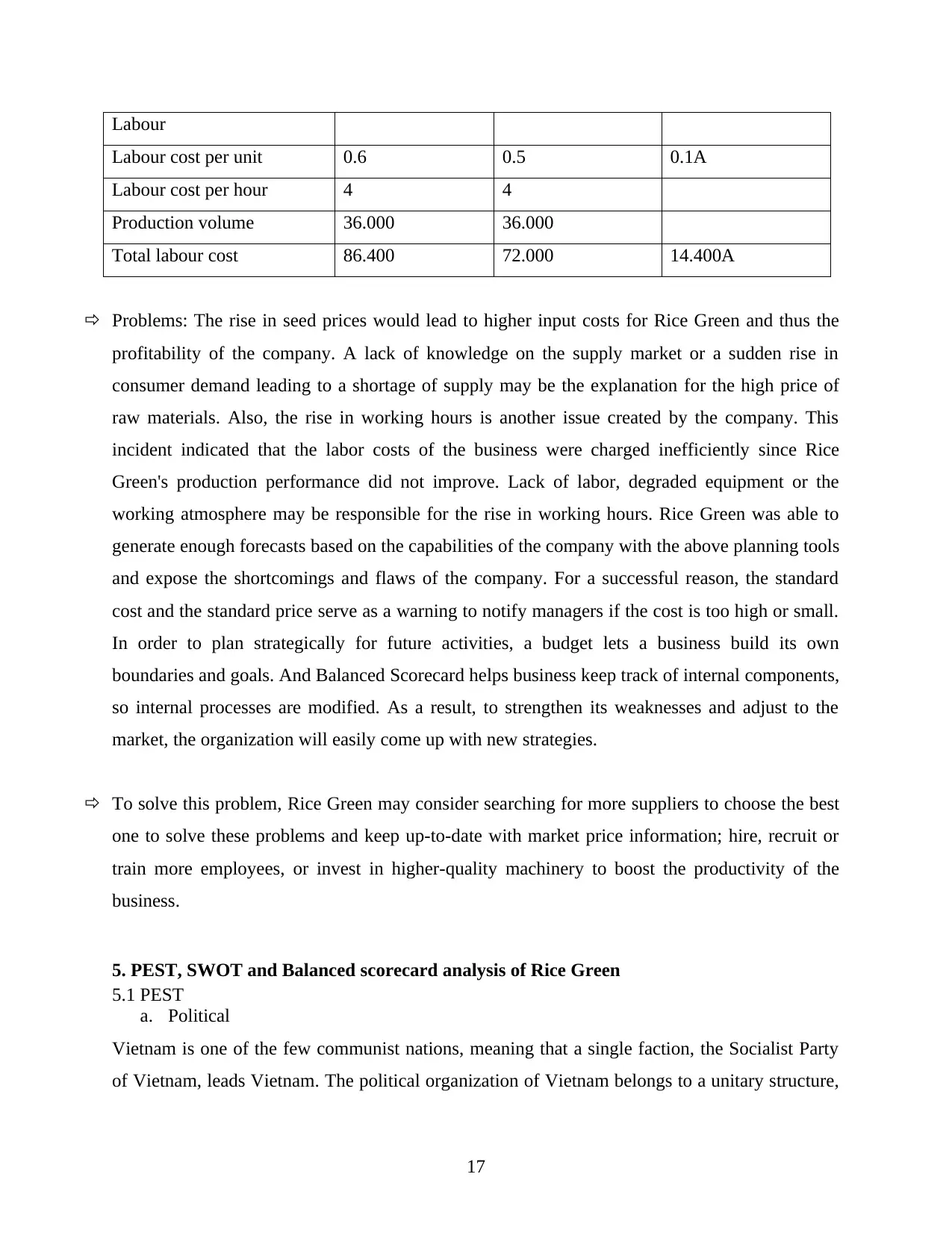
Labour
Labour cost per unit 0.6 0.5 0.1A
Labour cost per hour 4 4
Production volume 36.000 36.000
Total labour cost 86.400 72.000 14.400A
Problems: The rise in seed prices would lead to higher input costs for Rice Green and thus the
profitability of the company. A lack of knowledge on the supply market or a sudden rise in
consumer demand leading to a shortage of supply may be the explanation for the high price of
raw materials. Also, the rise in working hours is another issue created by the company. This
incident indicated that the labor costs of the business were charged inefficiently since Rice
Green's production performance did not improve. Lack of labor, degraded equipment or the
working atmosphere may be responsible for the rise in working hours. Rice Green was able to
generate enough forecasts based on the capabilities of the company with the above planning tools
and expose the shortcomings and flaws of the company. For a successful reason, the standard
cost and the standard price serve as a warning to notify managers if the cost is too high or small.
In order to plan strategically for future activities, a budget lets a business build its own
boundaries and goals. And Balanced Scorecard helps business keep track of internal components,
so internal processes are modified. As a result, to strengthen its weaknesses and adjust to the
market, the organization will easily come up with new strategies.
To solve this problem, Rice Green may consider searching for more suppliers to choose the best
one to solve these problems and keep up-to-date with market price information; hire, recruit or
train more employees, or invest in higher-quality machinery to boost the productivity of the
business.
5. PEST, SWOT and Balanced scorecard analysis of Rice Green
5.1 PEST
a. Political
Vietnam is one of the few communist nations, meaning that a single faction, the Socialist Party
of Vietnam, leads Vietnam. The political organization of Vietnam belongs to a unitary structure,
17
Labour cost per unit 0.6 0.5 0.1A
Labour cost per hour 4 4
Production volume 36.000 36.000
Total labour cost 86.400 72.000 14.400A
Problems: The rise in seed prices would lead to higher input costs for Rice Green and thus the
profitability of the company. A lack of knowledge on the supply market or a sudden rise in
consumer demand leading to a shortage of supply may be the explanation for the high price of
raw materials. Also, the rise in working hours is another issue created by the company. This
incident indicated that the labor costs of the business were charged inefficiently since Rice
Green's production performance did not improve. Lack of labor, degraded equipment or the
working atmosphere may be responsible for the rise in working hours. Rice Green was able to
generate enough forecasts based on the capabilities of the company with the above planning tools
and expose the shortcomings and flaws of the company. For a successful reason, the standard
cost and the standard price serve as a warning to notify managers if the cost is too high or small.
In order to plan strategically for future activities, a budget lets a business build its own
boundaries and goals. And Balanced Scorecard helps business keep track of internal components,
so internal processes are modified. As a result, to strengthen its weaknesses and adjust to the
market, the organization will easily come up with new strategies.
To solve this problem, Rice Green may consider searching for more suppliers to choose the best
one to solve these problems and keep up-to-date with market price information; hire, recruit or
train more employees, or invest in higher-quality machinery to boost the productivity of the
business.
5. PEST, SWOT and Balanced scorecard analysis of Rice Green
5.1 PEST
a. Political
Vietnam is one of the few communist nations, meaning that a single faction, the Socialist Party
of Vietnam, leads Vietnam. The political organization of Vietnam belongs to a unitary structure,
17
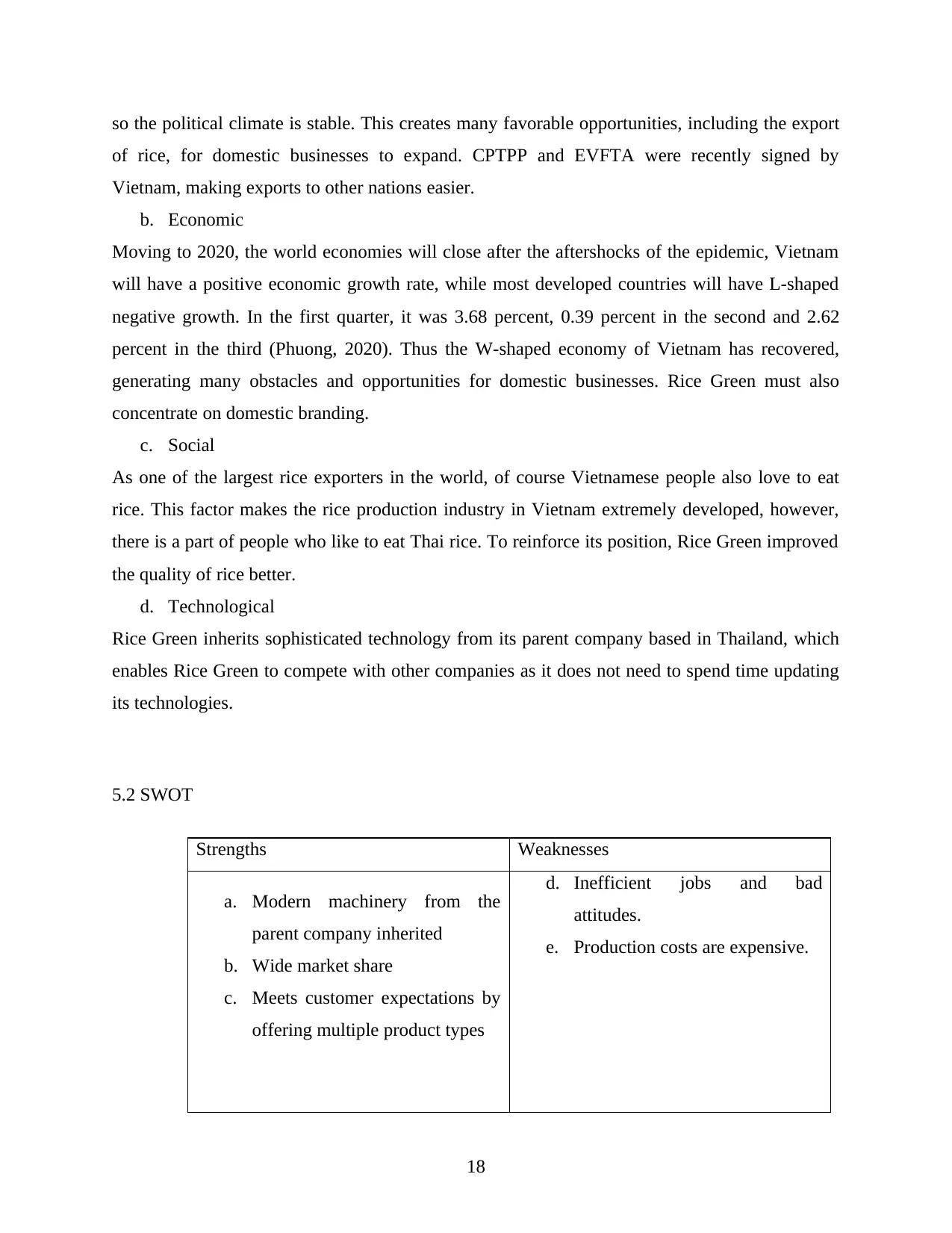
so the political climate is stable. This creates many favorable opportunities, including the export
of rice, for domestic businesses to expand. CPTPP and EVFTA were recently signed by
Vietnam, making exports to other nations easier.
b. Economic
Moving to 2020, the world economies will close after the aftershocks of the epidemic, Vietnam
will have a positive economic growth rate, while most developed countries will have L-shaped
negative growth. In the first quarter, it was 3.68 percent, 0.39 percent in the second and 2.62
percent in the third (Phuong, 2020). Thus the W-shaped economy of Vietnam has recovered,
generating many obstacles and opportunities for domestic businesses. Rice Green must also
concentrate on domestic branding.
c. Social
As one of the largest rice exporters in the world, of course Vietnamese people also love to eat
rice. This factor makes the rice production industry in Vietnam extremely developed, however,
there is a part of people who like to eat Thai rice. To reinforce its position, Rice Green improved
the quality of rice better.
d. Technological
Rice Green inherits sophisticated technology from its parent company based in Thailand, which
enables Rice Green to compete with other companies as it does not need to spend time updating
its technologies.
5.2 SWOT
Strengths Weaknesses
a. Modern machinery from the
parent company inherited
b. Wide market share
c. Meets customer expectations by
offering multiple product types
d. Inefficient jobs and bad
attitudes.
e. Production costs are expensive.
18
of rice, for domestic businesses to expand. CPTPP and EVFTA were recently signed by
Vietnam, making exports to other nations easier.
b. Economic
Moving to 2020, the world economies will close after the aftershocks of the epidemic, Vietnam
will have a positive economic growth rate, while most developed countries will have L-shaped
negative growth. In the first quarter, it was 3.68 percent, 0.39 percent in the second and 2.62
percent in the third (Phuong, 2020). Thus the W-shaped economy of Vietnam has recovered,
generating many obstacles and opportunities for domestic businesses. Rice Green must also
concentrate on domestic branding.
c. Social
As one of the largest rice exporters in the world, of course Vietnamese people also love to eat
rice. This factor makes the rice production industry in Vietnam extremely developed, however,
there is a part of people who like to eat Thai rice. To reinforce its position, Rice Green improved
the quality of rice better.
d. Technological
Rice Green inherits sophisticated technology from its parent company based in Thailand, which
enables Rice Green to compete with other companies as it does not need to spend time updating
its technologies.
5.2 SWOT
Strengths Weaknesses
a. Modern machinery from the
parent company inherited
b. Wide market share
c. Meets customer expectations by
offering multiple product types
d. Inefficient jobs and bad
attitudes.
e. Production costs are expensive.
18
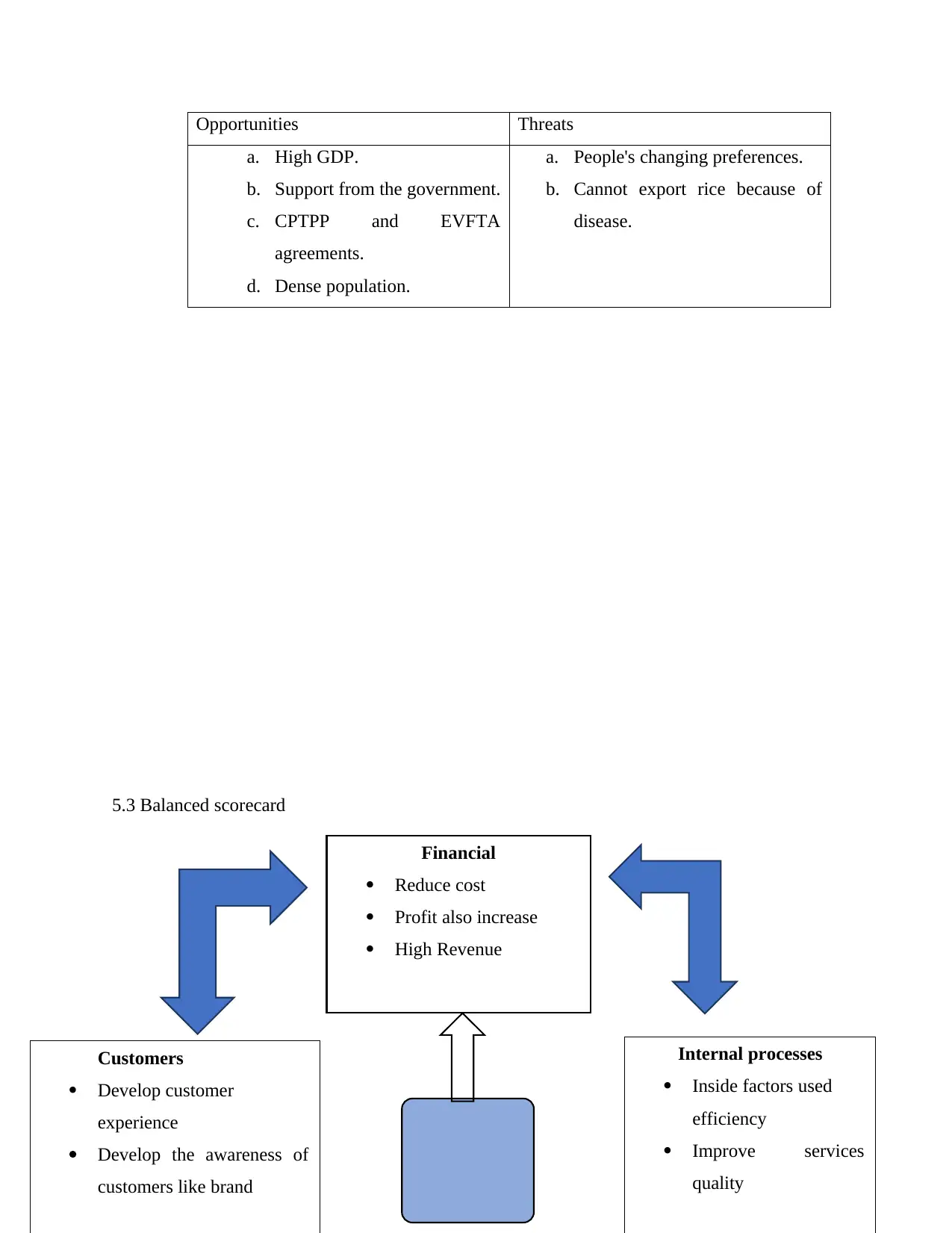
Opportunities Threats
a. High GDP.
b. Support from the government.
c. CPTPP and EVFTA
agreements.
d. Dense population.
a. People's changing preferences.
b. Cannot export rice because of
disease.
5.3 Balanced scorecard
1.
2.
19
Customers
Develop customer
experience
Develop the awareness of
customers like brand
Internal processes
Inside factors used
efficiency
Improve services
quality
Financial
Reduce cost
Profit also increase
High Revenue
a. High GDP.
b. Support from the government.
c. CPTPP and EVFTA
agreements.
d. Dense population.
a. People's changing preferences.
b. Cannot export rice because of
disease.
5.3 Balanced scorecard
1.
2.
19
Customers
Develop customer
experience
Develop the awareness of
customers like brand
Internal processes
Inside factors used
efficiency
Improve services
quality
Financial
Reduce cost
Profit also increase
High Revenue
Paraphrase This Document
Need a fresh take? Get an instant paraphrase of this document with our AI Paraphraser
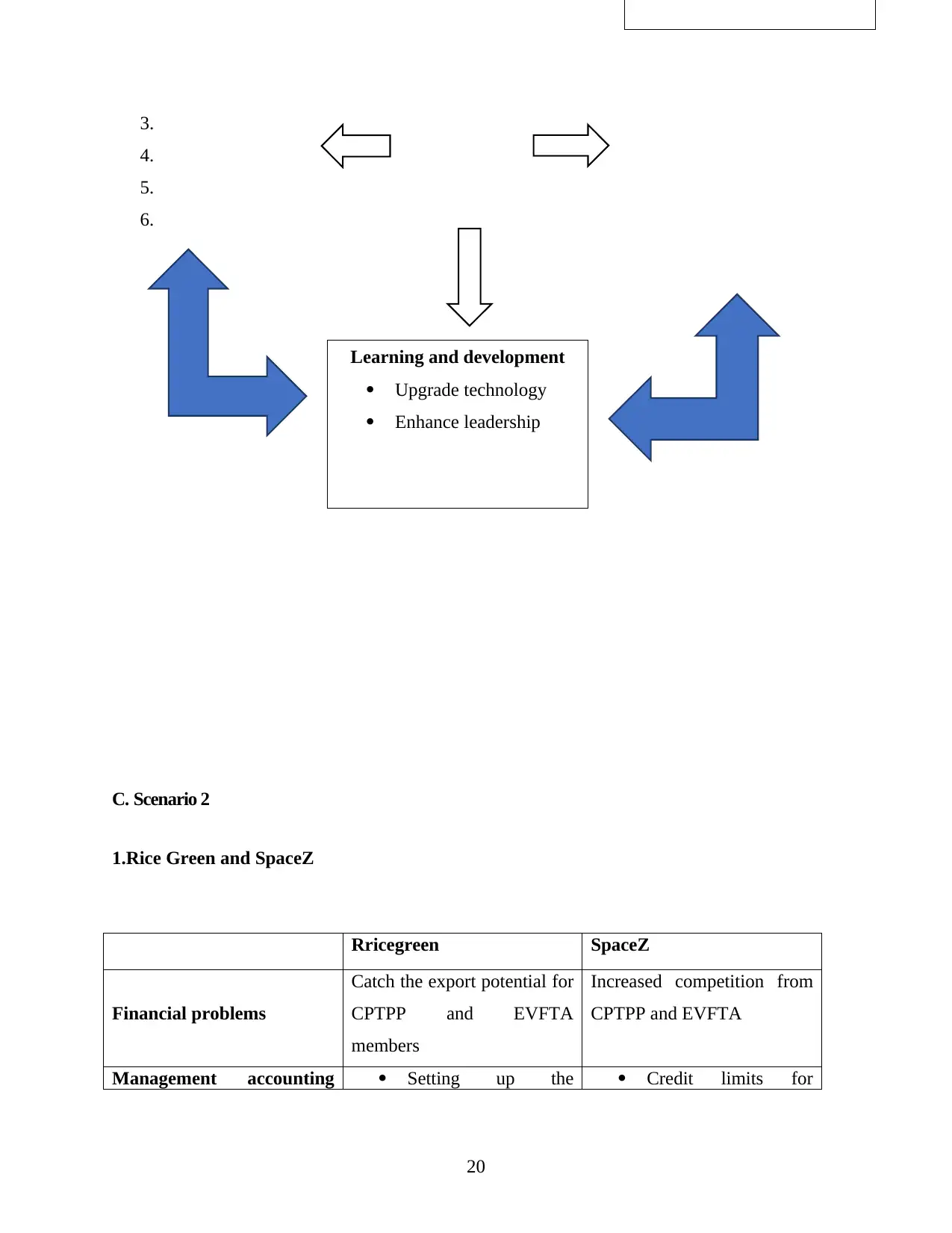
3.
4.
5.
6.
C. Scenario 2
1.Rice Green and SpaceZ
Rricegreen SpaceZ
Financial problems
Catch the export potential for
CPTPP and EVFTA
members
Increased competition from
CPTPP and EVFTA
Management accounting Setting up the Credit limits for
20
Learning and development
Upgrade technology
Enhance leadership
4.
5.
6.
C. Scenario 2
1.Rice Green and SpaceZ
Rricegreen SpaceZ
Financial problems
Catch the export potential for
CPTPP and EVFTA
members
Increased competition from
CPTPP and EVFTA
Management accounting Setting up the Credit limits for
20
Learning and development
Upgrade technology
Enhance leadership
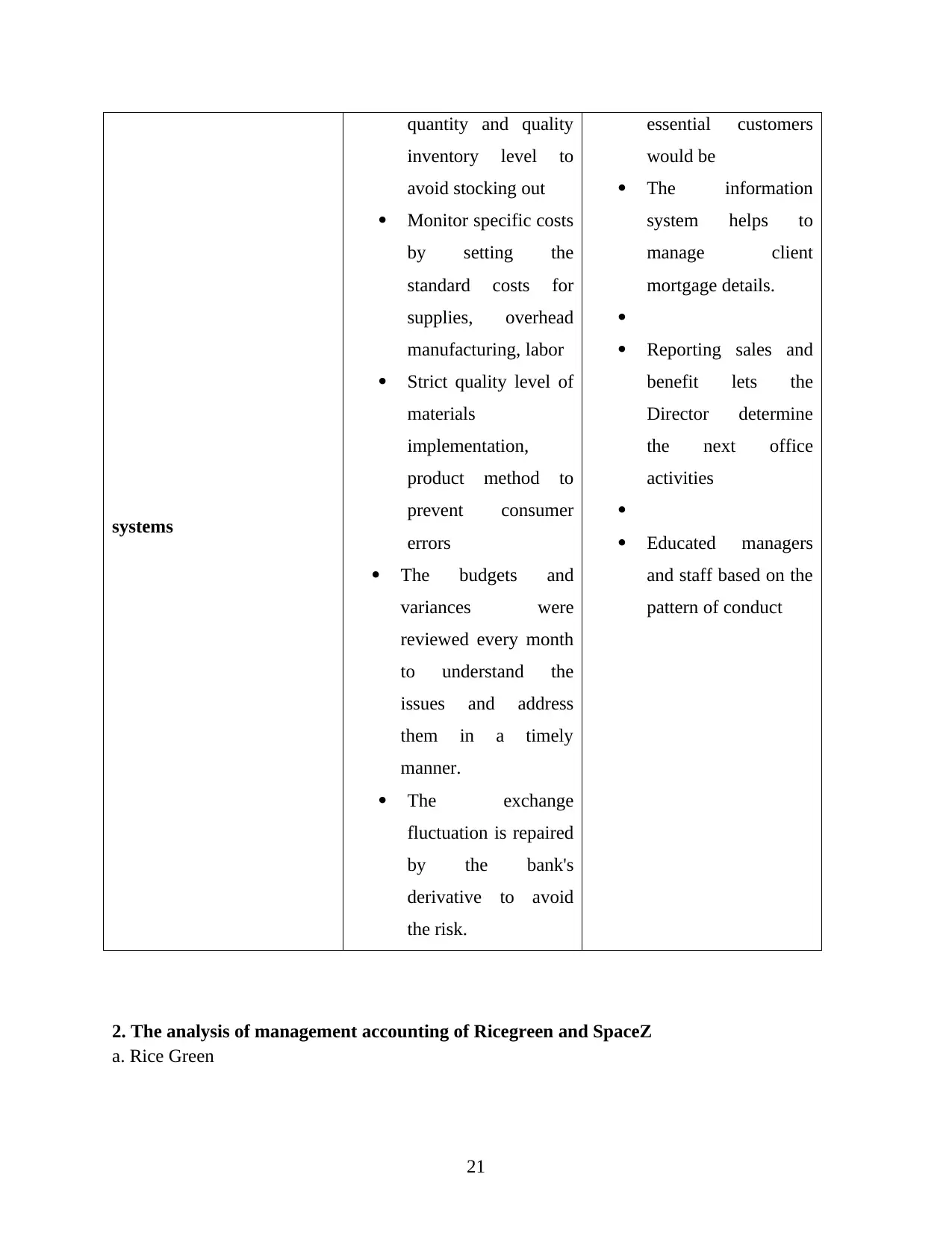
systems
quantity and quality
inventory level to
avoid stocking out
Monitor specific costs
by setting the
standard costs for
supplies, overhead
manufacturing, labor
Strict quality level of
materials
implementation,
product method to
prevent consumer
errors
The budgets and
variances were
reviewed every month
to understand the
issues and address
them in a timely
manner.
The exchange
fluctuation is repaired
by the bank's
derivative to avoid
the risk.
essential customers
would be
The information
system helps to
manage client
mortgage details.
Reporting sales and
benefit lets the
Director determine
the next office
activities
Educated managers
and staff based on the
pattern of conduct
2. The analysis of management accounting of Ricegreen and SpaceZ
a. Rice Green
21
quantity and quality
inventory level to
avoid stocking out
Monitor specific costs
by setting the
standard costs for
supplies, overhead
manufacturing, labor
Strict quality level of
materials
implementation,
product method to
prevent consumer
errors
The budgets and
variances were
reviewed every month
to understand the
issues and address
them in a timely
manner.
The exchange
fluctuation is repaired
by the bank's
derivative to avoid
the risk.
essential customers
would be
The information
system helps to
manage client
mortgage details.
Reporting sales and
benefit lets the
Director determine
the next office
activities
Educated managers
and staff based on the
pattern of conduct
2. The analysis of management accounting of Ricegreen and SpaceZ
a. Rice Green
21
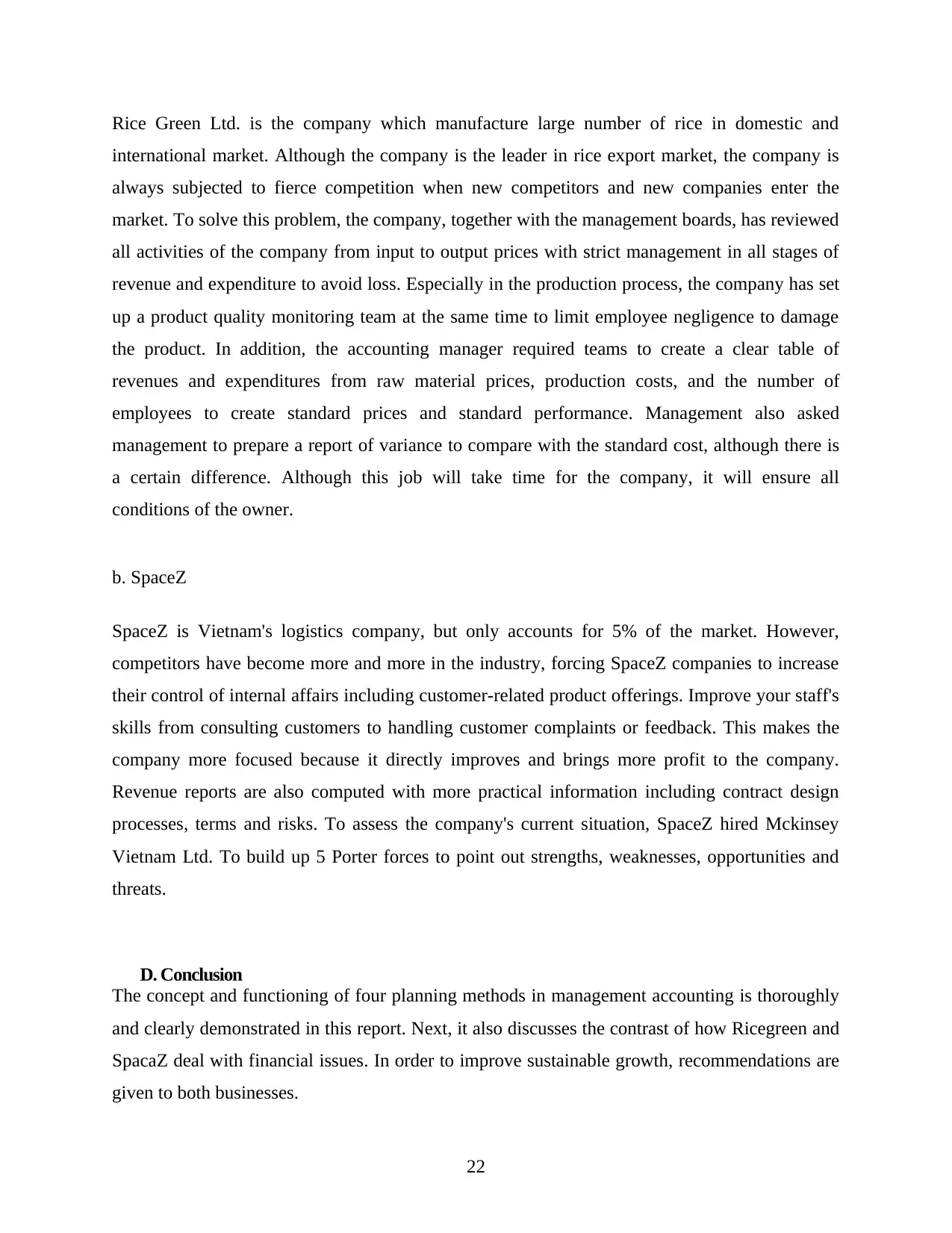
Rice Green Ltd. is the company which manufacture large number of rice in domestic and
international market. Although the company is the leader in rice export market, the company is
always subjected to fierce competition when new competitors and new companies enter the
market. To solve this problem, the company, together with the management boards, has reviewed
all activities of the company from input to output prices with strict management in all stages of
revenue and expenditure to avoid loss. Especially in the production process, the company has set
up a product quality monitoring team at the same time to limit employee negligence to damage
the product. In addition, the accounting manager required teams to create a clear table of
revenues and expenditures from raw material prices, production costs, and the number of
employees to create standard prices and standard performance. Management also asked
management to prepare a report of variance to compare with the standard cost, although there is
a certain difference. Although this job will take time for the company, it will ensure all
conditions of the owner.
b. SpaceZ
SpaceZ is Vietnam's logistics company, but only accounts for 5% of the market. However,
competitors have become more and more in the industry, forcing SpaceZ companies to increase
their control of internal affairs including customer-related product offerings. Improve your staff's
skills from consulting customers to handling customer complaints or feedback. This makes the
company more focused because it directly improves and brings more profit to the company.
Revenue reports are also computed with more practical information including contract design
processes, terms and risks. To assess the company's current situation, SpaceZ hired Mckinsey
Vietnam Ltd. To build up 5 Porter forces to point out strengths, weaknesses, opportunities and
threats.
D. Conclusion
The concept and functioning of four planning methods in management accounting is thoroughly
and clearly demonstrated in this report. Next, it also discusses the contrast of how Ricegreen and
SpacaZ deal with financial issues. In order to improve sustainable growth, recommendations are
given to both businesses.
22
international market. Although the company is the leader in rice export market, the company is
always subjected to fierce competition when new competitors and new companies enter the
market. To solve this problem, the company, together with the management boards, has reviewed
all activities of the company from input to output prices with strict management in all stages of
revenue and expenditure to avoid loss. Especially in the production process, the company has set
up a product quality monitoring team at the same time to limit employee negligence to damage
the product. In addition, the accounting manager required teams to create a clear table of
revenues and expenditures from raw material prices, production costs, and the number of
employees to create standard prices and standard performance. Management also asked
management to prepare a report of variance to compare with the standard cost, although there is
a certain difference. Although this job will take time for the company, it will ensure all
conditions of the owner.
b. SpaceZ
SpaceZ is Vietnam's logistics company, but only accounts for 5% of the market. However,
competitors have become more and more in the industry, forcing SpaceZ companies to increase
their control of internal affairs including customer-related product offerings. Improve your staff's
skills from consulting customers to handling customer complaints or feedback. This makes the
company more focused because it directly improves and brings more profit to the company.
Revenue reports are also computed with more practical information including contract design
processes, terms and risks. To assess the company's current situation, SpaceZ hired Mckinsey
Vietnam Ltd. To build up 5 Porter forces to point out strengths, weaknesses, opportunities and
threats.
D. Conclusion
The concept and functioning of four planning methods in management accounting is thoroughly
and clearly demonstrated in this report. Next, it also discusses the contrast of how Ricegreen and
SpacaZ deal with financial issues. In order to improve sustainable growth, recommendations are
given to both businesses.
22
1 out of 22
Related Documents
Your All-in-One AI-Powered Toolkit for Academic Success.
+13062052269
info@desklib.com
Available 24*7 on WhatsApp / Email
![[object Object]](/_next/static/media/star-bottom.7253800d.svg)
Unlock your academic potential
© 2024 | Zucol Services PVT LTD | All rights reserved.





